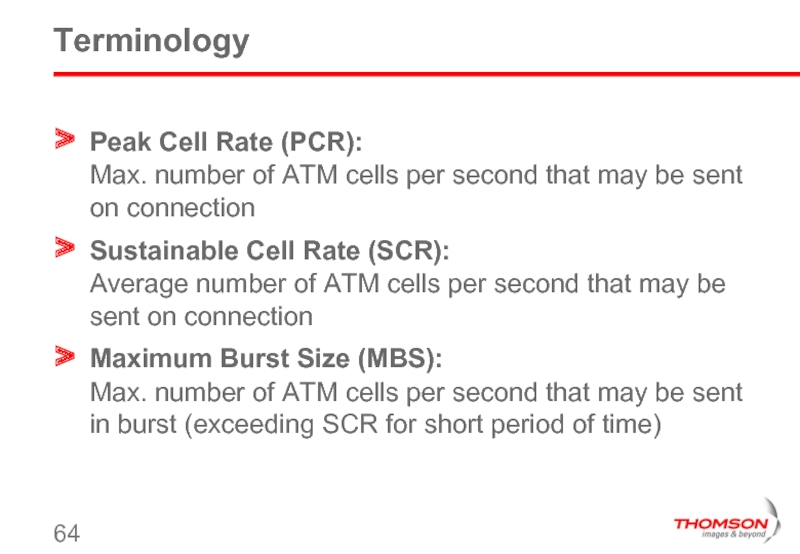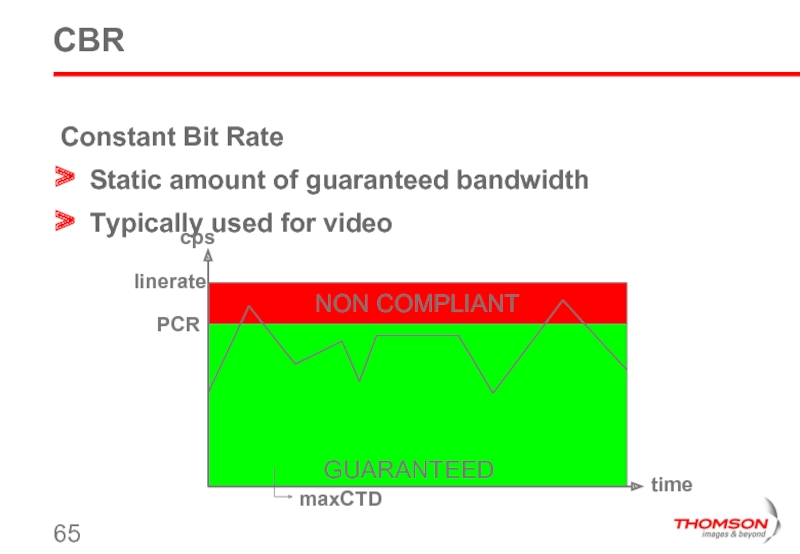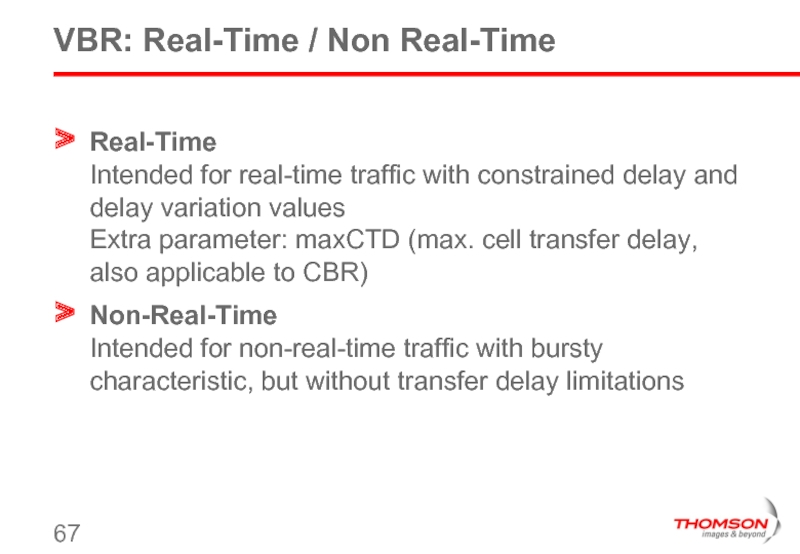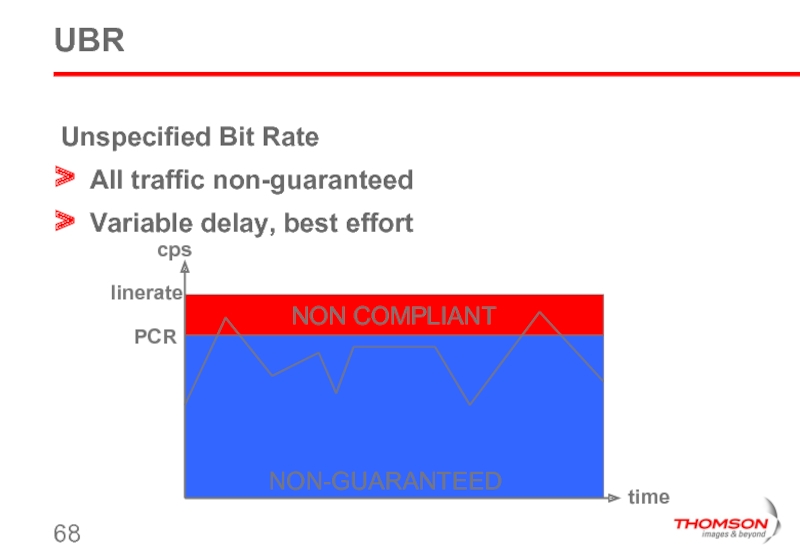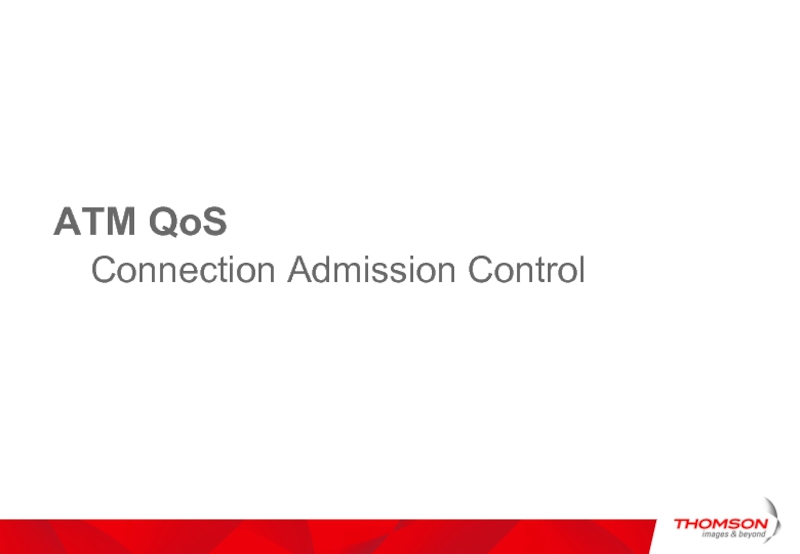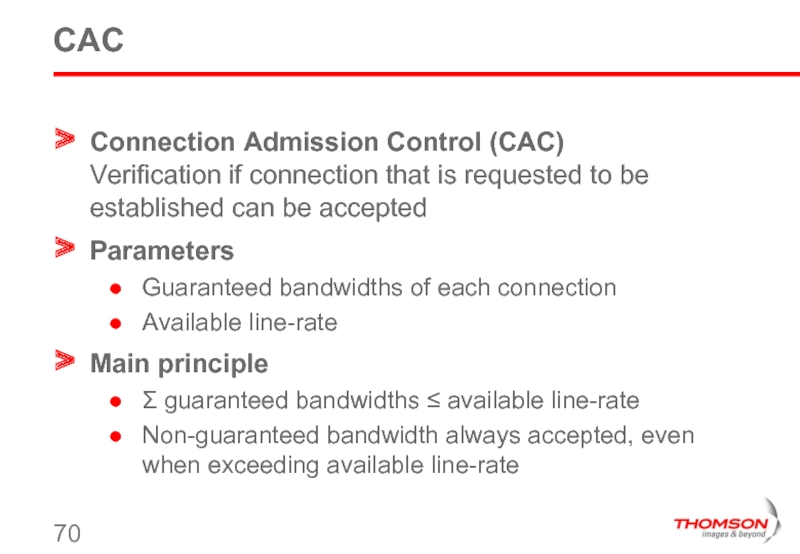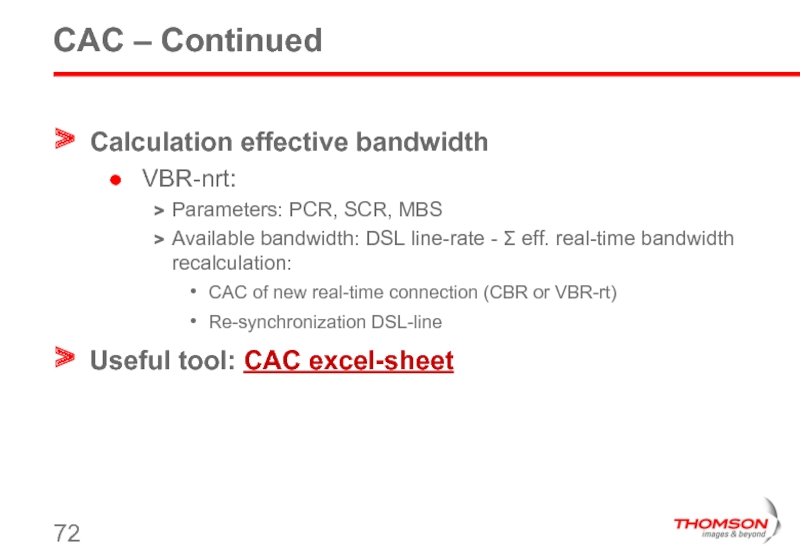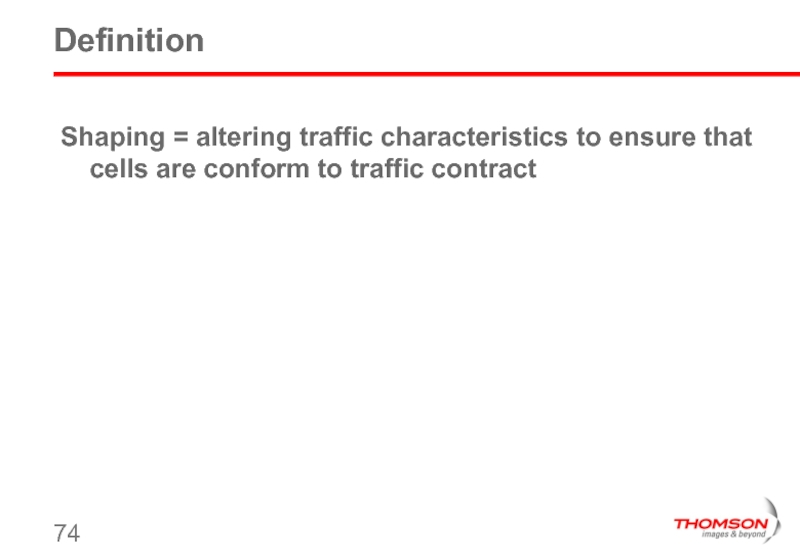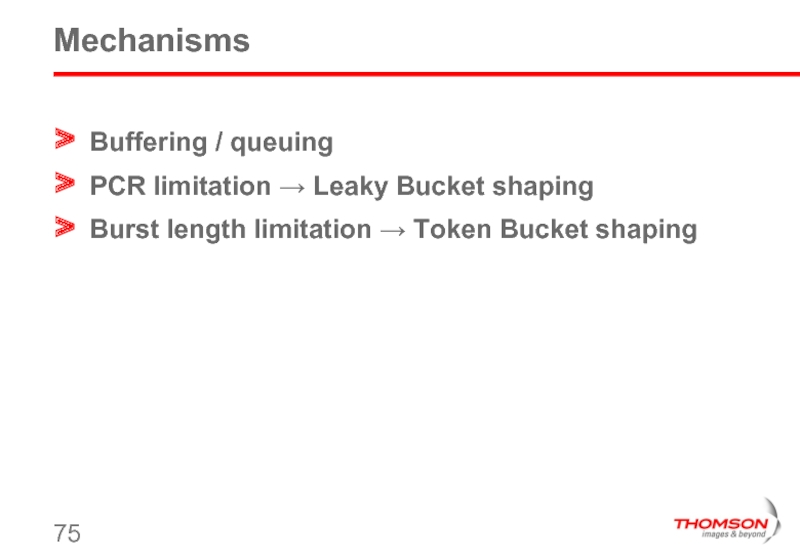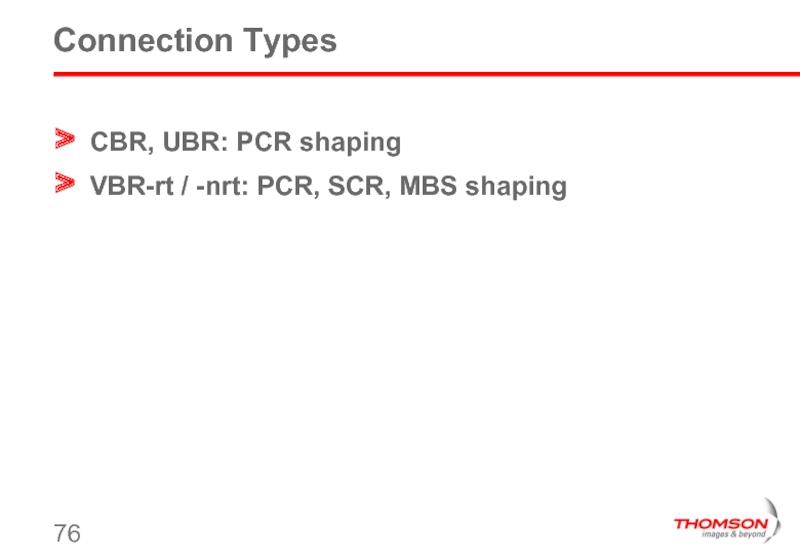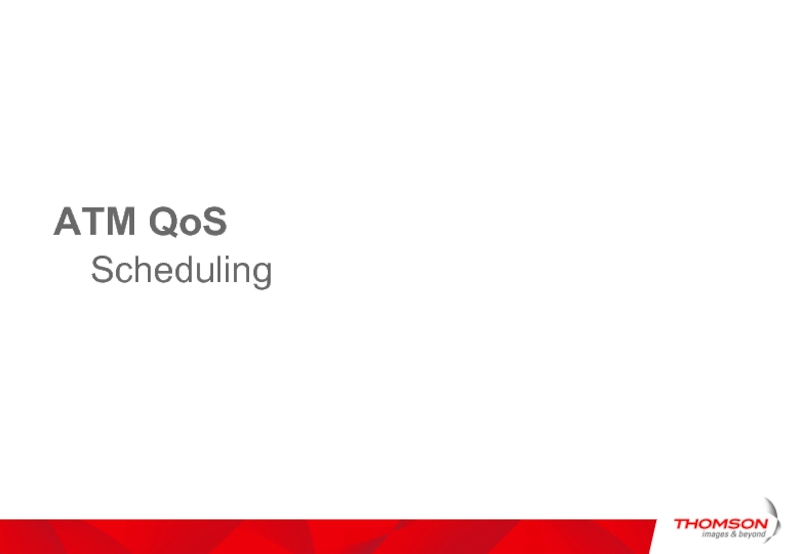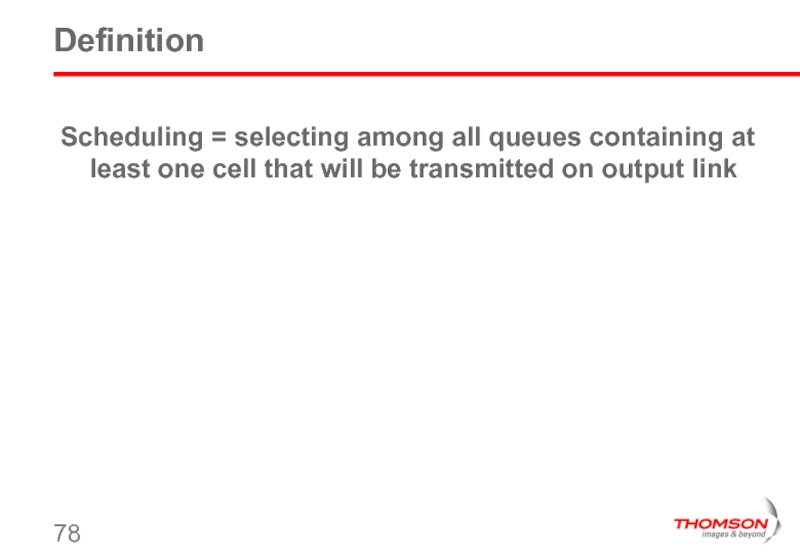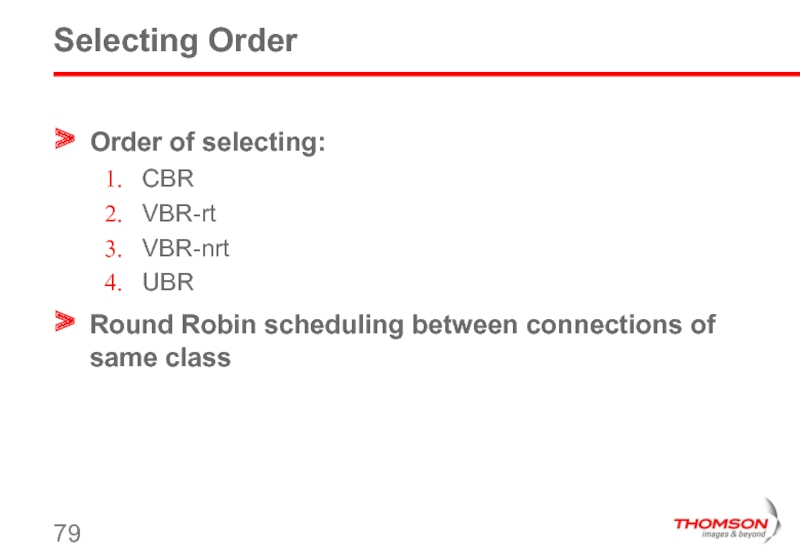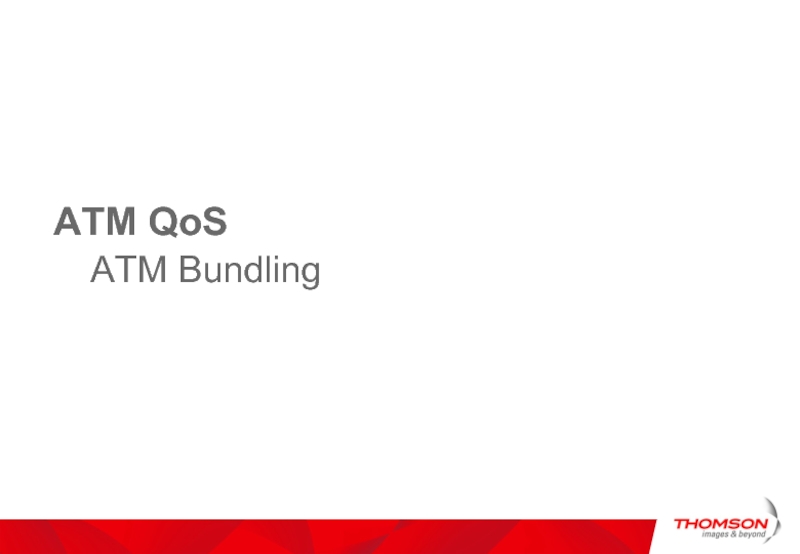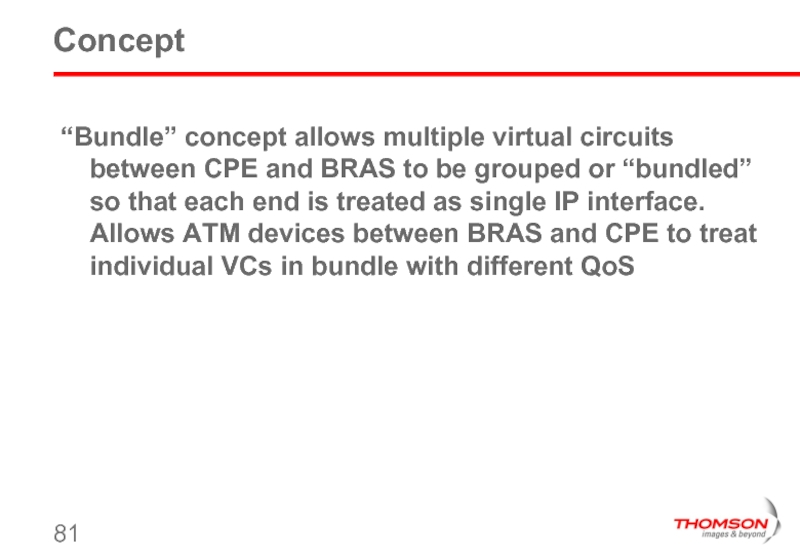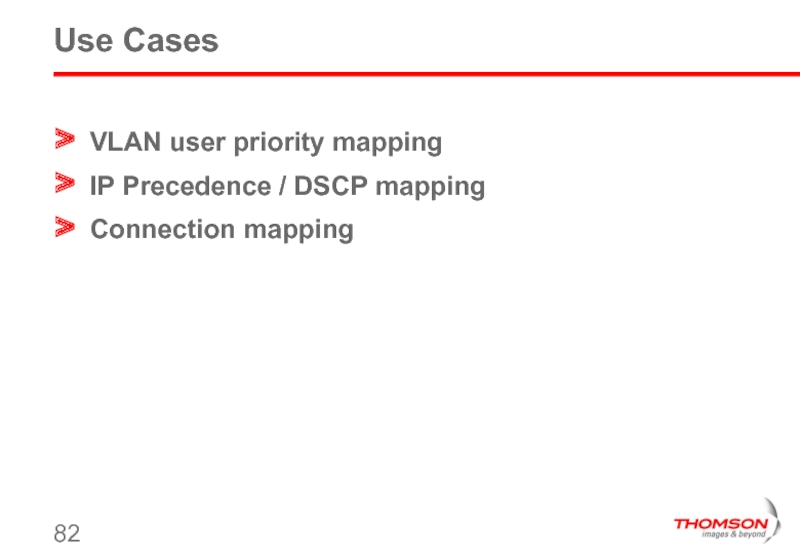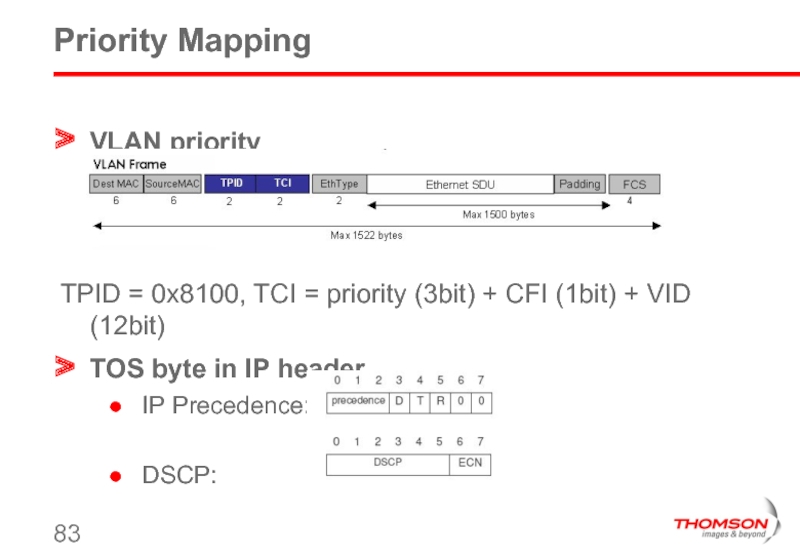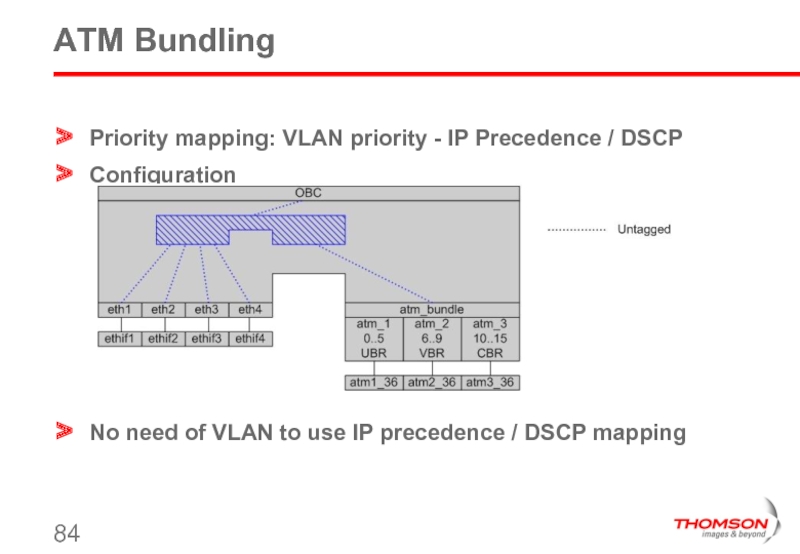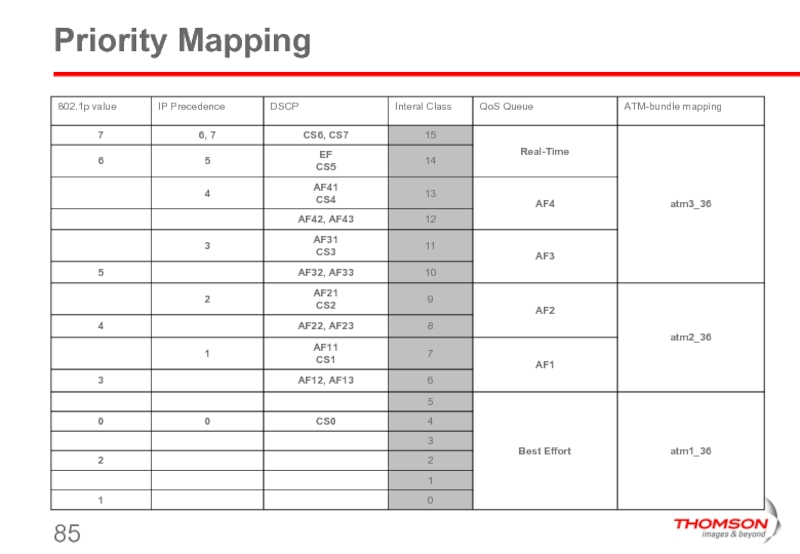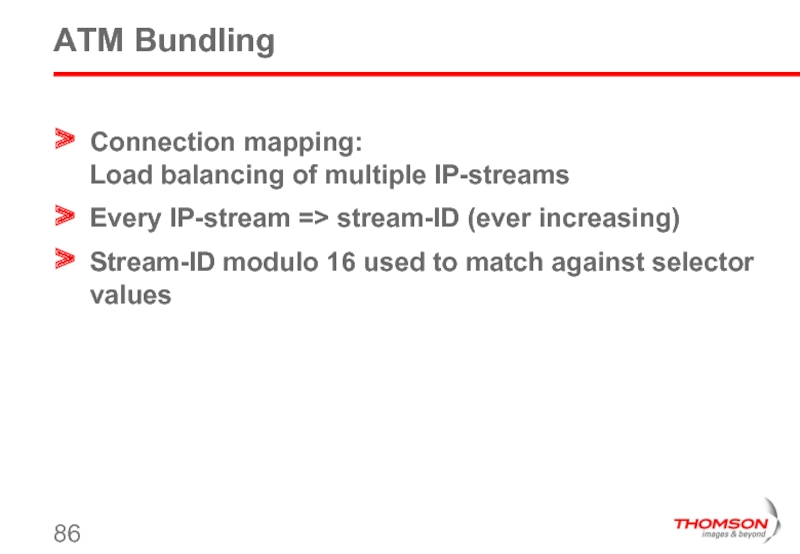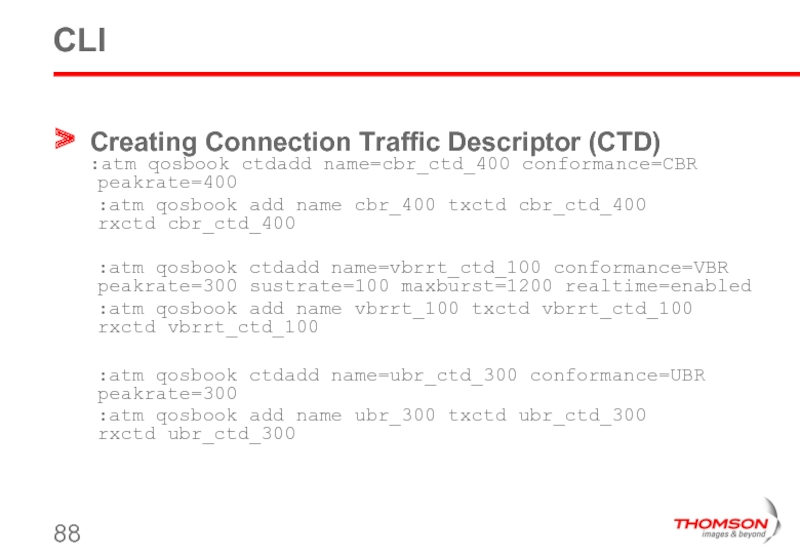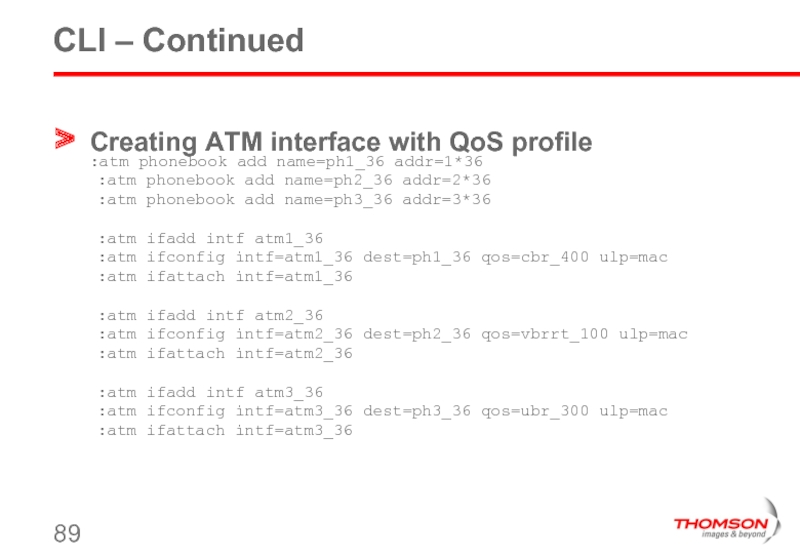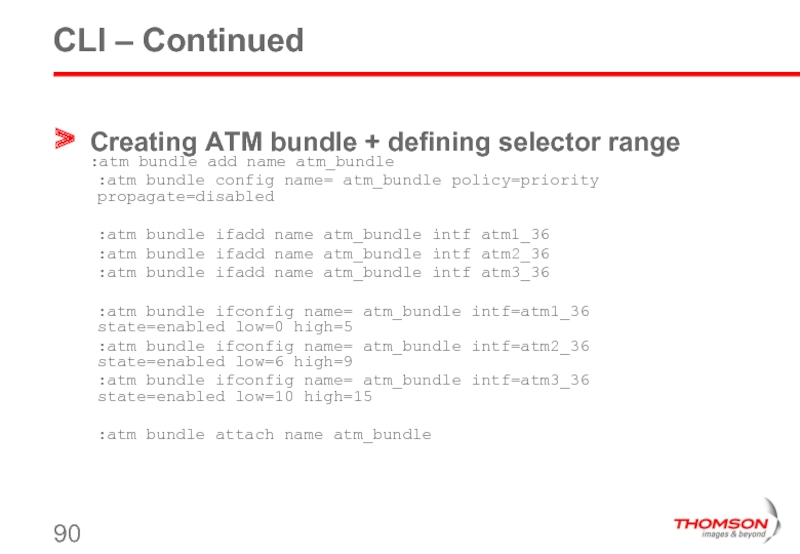- Главная
- Разное
- Дизайн
- Бизнес и предпринимательство
- Аналитика
- Образование
- Развлечения
- Красота и здоровье
- Финансы
- Государство
- Путешествия
- Спорт
- Недвижимость
- Армия
- Графика
- Культурология
- Еда и кулинария
- Лингвистика
- Английский язык
- Астрономия
- Алгебра
- Биология
- География
- Детские презентации
- Информатика
- История
- Литература
- Маркетинг
- Математика
- Медицина
- Менеджмент
- Музыка
- МХК
- Немецкий язык
- ОБЖ
- Обществознание
- Окружающий мир
- Педагогика
- Русский язык
- Технология
- Физика
- Философия
- Химия
- Шаблоны, картинки для презентаций
- Экология
- Экономика
- Юриспруденция
Quality of Service 3 Overview > What is QoS? What is QoS? > Label-Based Routing Label-Based Routing > IPQoS IPQoS > ATM QoS ATM QoS > CLI CLI. презентация
Содержание
- 2. Quality of Service
- 3. Overview What is QoS? Label-Based Routing IPQoS ATM QoS CLI
- 4. QoS What is QoS?
- 5. Definition QoS = ability of network element
- 6. QoS Approaches Relative QoS Example: Differentiated Services,
- 7. QoS Label-Based Routing
- 8. Overview History and Now Classification and Routing Configuration Example
- 9. Label-Based Routing: History = Evolution of source-based
- 10. Label-Based Routing: Now Available from R4.2 onwards
- 11. Classification and Routing Classification: before routing packet
- 12. Classification and Routing – Continued First match
- 13. Classification and Routing – Illustrated
- 14. Configuration CLI only Label menu Creation / deletion of labels TOS marking possible
- 15. Configuration – Continued Label / rule menu
- 16. Labelling Mechanism
- 17. Rules Source Interface (preferably NOT used) [srcintf
- 18. Rules – Continued ToS (tagging) tos [!]=
- 19. Rules – Continued Known ports = {echo|discard|systat|daytime|qotd|chargen|ftp-data|ftp|telnet|smtp|time|nicname|dns|domain |sql*net|bootps|bootpctftp|gopher|finger|www-http|kerberos|rtelnet|pop2|pop3|sunrpc|auth|sqlserv|nntp|sntp|ntp |ingres-net|netbios-ns|netbios-dgm|netbios-ssn|imap2|sql-net|pcmail-srv|snmp|snmptrap|bgp|irc-o|at-rtmp |at-nbp|at-echo|at-zis|ipx|imap3|clearcase|ulistserv|ldap|netware-ip|snpp|ike|exec|biff|login|who|syslog |printer|talk|ntalk|utime|rip|timed|netwall|uucp|uucp-rlogin|new-rwho|rtsp|...} or number>
- 20. Example Scenario: 2 PPPoA sessions with traffic
- 21. Example: Network Setup SpeedTouch 610 Eth0 :
- 22. Configuration: Example Start from configuration with 2
- 23. Configuration: Example – Continued Create routes to
- 24. QoS IPQoS
- 25. Overview Features Implementation Configuration Example Scenario
- 26. New Features: Problem Solving WAN Gateway Packet
- 27. New Features: How It Works – 600
- 28. New Features: How It Works – 500
- 29. New Features: How It Works – For Dummies Through well-chosen defaults in templates
- 30. New Features: What Is Kept for R5.3 Per flow rate limiting ALG-based labelling Head-of-Line blocking
- 31. Implementation in 4.2.7 Classification and labelling IPQoS
- 32. Implementation in 4.2.7 – Continued Classification of
- 33. High-Level Module Overview Automatic class mapping: VLAN User Priority ATM QoS
- 34. High-Level Module Overview – Example DSCP – AF/EF
- 35. Routed Data Path – WFQ
- 36. Configuration intf IPQoS configuration Queuing mechanism Queuing
- 37. IPQoS Configuration – CLI dest = destination
- 38. IPQoS Queue Configuration – CLI Propagation from
- 39. Default Set of Labels WFQ per VP / VC
- 40. Labels – CLI Label add name
- 41. Labels – CLI – Illustrated
- 42. Labels / Rules Rules = Label-based routing
- 43. IPQoS: Example 1 SpeedTouch 610 Eth0 :
- 44. Example 1 =>:ip ifconfig intf=ipoa dest=ipoa-qos =>:ip
- 45. Statistics UDP flood from PC VoIP call
- 46. Example 2: WFQ SpeedTouch 610 Eth0 :
- 47. Example 2: WFQ – Continued :ipqos config
- 48. Example 3 ACK SpeedTouch 610 Eth0 :
- 49. ACK
- 50. IPQoS Scenario – WFQ ATM 512kb uplink
- 51. IPQoS Scenario – BW RealTime traffic has
- 52. IPQoS Scenario – BW – Continued All
- 53. Upstream BW Theoretical subdivide = max RT
- 54. IPQoS Scenario – Configuration
- 55. IPQoS Scenario – Label
- 56. Scenario Overview SpeedTouch 610 Eth0 : 10.0.0.138
- 57. Label Rule Stats Are labels matching?
- 58. IPQoS Queue Stats Clear stats: => ipqos queue stats clear enable
- 59. user.ini [ phone.ini ] add name=dsl addr=0*38
- 60. user.ini – Continued [ label.ini ] add
- 61. ATM QoS
- 62. Overview QoS Profiles Connection Admission Control Shaping Scheduling ATM Bundling
- 63. ATM QoS QoS Profiles
- 64. Terminology Peak Cell Rate (PCR): Max. number
- 65. CBR Constant Bit Rate Static amount of
- 66. VBR Variable Bit Rate Variable amount of
- 67. VBR: Real-Time / Non Real-Time Real-Time Intended
- 68. UBR Unspecified Bit Rate All traffic non-guaranteed
- 69. ATM QoS Connection Admission Control
- 70. CAC Connection Admission Control (CAC) Verification if
- 71. CAC – Continued Calculation effective bandwidth: CBR
- 72. CAC – Continued Calculation effective bandwidth VBR-nrt:
- 73. ATM QoS Shaping
- 74. Definition Shaping = altering traffic characteristics to ensure that cells are conform to traffic contract
- 75. Mechanisms Buffering / queuing PCR limitation →
- 76. Connection Types CBR, UBR: PCR shaping VBR-rt / -nrt: PCR, SCR, MBS shaping
- 77. ATM QoS Scheduling
- 78. Definition Scheduling = selecting among all queues
- 79. Selecting Order Order of selecting: CBR VBR-rt
- 80. ATM QoS ATM Bundling
- 81. Concept “Bundle” concept allows multiple virtual circuits
- 82. Use Cases VLAN user priority mapping IP Precedence / DSCP mapping Connection mapping
- 83. Priority Mapping VLAN priority
- 84. ATM Bundling Priority mapping: VLAN priority -
- 85. Priority Mapping
- 86. ATM Bundling Connection mapping: Load balancing of
- 87. CLI
- 88. CLI Creating Connection Traffic Descriptor (CTD) :atm
- 89. CLI – Continued Creating ATM interface with
- 90. CLI – Continued Creating ATM bundle +
- 91. CLI – Continued Priority mapping: enable on
Слайд 5Definition
QoS = ability of network element to have some level of
Слайд 6QoS Approaches
Relative QoS
Example: Differentiated Services, VLAN user priority
Guaranteed QoS
Example: Integrated Services,
Слайд 9Label-Based Routing: History
= Evolution of source-based routing
Source-based routing:
Present in all SpeedTouch
Allows to route traffic source and destination-based to certain gateways or ports (= atm pvcs)
= Fixed label with only source address parameter
Слайд 10Label-Based Routing: Now
Available from R4.2 onwards
Classification of traffic on many criteria
Reuses
Traffic routing through different ATM PVCs with different QoS classes
Can be combined with IPQoS in future
Слайд 11Classification and Routing
Classification: before routing packet enters router and is classified
Labels
Routes with labels have highest priority
Routes with labels only route packets with correct labels
Слайд 12Classification and Routing – Continued
First match is chosen
Use of traffic stream
First time: slow path
Next time: fast path
Слайд 15Configuration – Continued
Label / rule menu
Creation / deletion of rules
Default chain
Used for backward compatibility or when configuring source-based routes
Default chain linked to user_labels
User_labels chain to be used only
Every new rule must be attached to user_labels with certain index
Statistics possible: rule stats
Слайд 17Rules
Source Interface (preferably NOT used)
[srcintf [!]= ]
Source Interface Group (preferably
[srcintfgrp [!]= <{wan|local|lan} or number>]
IP
src [!]=
dst [!]=
Слайд 18Rules – Continued
ToS (tagging)
tos [!]=
precedence [!]=
dscp [!]=
Protocol
prot [!]
Port
srcport [!] & srcportend
dstport [!] & dstportend
Слайд 19Rules – Continued
Known ports = {echo|discard|systat|daytime|qotd|chargen|ftp-data|ftp|telnet|smtp|time|nicname|dns|domain
|sql*net|bootps|bootpctftp|gopher|finger|www-http|kerberos|rtelnet|pop2|pop3|sunrpc|auth|sqlserv|nntp|sntp|ntp
|ingres-net|netbios-ns|netbios-dgm|netbios-ssn|imap2|sql-net|pcmail-srv|snmp|snmptrap|bgp|irc-o|at-rtmp
|at-nbp|at-echo|at-zis|ipx|imap3|clearcase|ulistserv|ldap|netware-ip|snpp|ike|exec|biff|login|who|syslog
|printer|talk|ntalk|utime|rip|timed|netwall|uucp|uucp-rlogin|new-rwho|rtsp|...} or number>
Слайд 20Example
Scenario:
2 PPPoA sessions with traffic separation
Session 1: PPPoA1: only icmp traffic
Session
4 labels required
Label ICMP rule 0: from LAN and protocol ICMP through PPPoA1
Label TCP rule 1: from LAN and protocol TCP through PPPoA2
Label UDP rule 2: from LAN and protocol UDP through PPPoA2
Label DNSLOCAL rule 3: from local and protocol UDP port 53
Слайд 21Example: Network Setup
SpeedTouch 610
Eth0 : 10.0.0.138
BRAS
Internet
PC A : 10.0.0.201
DG : 10.0.0.138
TCP
ICMP traffic, through pppoa1
PPPoA1
192.168.2.19
PPPoA2
192.168.2.21
Слайд 22Configuration: Example
Start from configuration with 2 PPPoA sessions
Create labels
:label add name=dnslocal
:label
:label add name=tcp
:label add name=udp
Create label rules
:label rule create chain=user_labels index=0 srcintfgrp=lan prot=icmp label=icmp
:label rule create chain=user_labels index=1 srcintfgrp=lan prot=tcp label=tcp
:label rule create chain=user_labels index=2 srcintfgrp=lan prot=udp label=udp
:label rule create chain=user_labels index=3 srcintfgrp=local prot=udp dstport=dns label=dnslocal
Слайд 23Configuration: Example – Continued
Create routes to PPPoA1 and PPPoA2
:ip rtadd dst=0.0.0.0/0
:ip rtadd dst=0.0.0.0/0 label=icmp intf=pppoa1
:ip rtadd dst=0.0.0.0/0 label=tcp intf=pppoa2
:ip rtadd dst=0.0.0.0/0 label=udp intf=pppoa2
Remark: PPP routes can be added
Through PPP session directly
Through IP menu → used in this example because multiple routes had to be added
Слайд 26New Features: Problem Solving
WAN
Gateway
Packet Loss
→ TCP slowdown
→ Voice degradation
→ Game hiccups
→
Delay
→ TCP choke (BW=Window/Delay)
→ Slow response time for web browsing
Delay Variation (jitter)
→ Extra buffering delay on voice
Слайд 27New Features: How It Works – 600 Series
WAN
Gateway
Best Effort
Highest Priority
Upstream IP
“labels”: IP header-based : configured on CPE
Diffserv Codepoints: set by applications
VLAN tags (802.1p): Set by endpoints?
TCP Ack => Ack filtering
Traffic assigned to 1 of 6 queues:
1: Expedited Forwarding: Absolute top
priority traffic (rate limited)
2-5: Assured Forwarding : each queue given
fair share of available bandwidth
6: Best Effort: take what is left
Слайд 28New Features: How It Works – 500 Series
LAN
WAN
Gateway
Best Effort
Highest Priority
Residential QoS
Plug and play operation: VLAN, DiffServ
Priority:
EF: VoIP, Gaming
AF: interactive sessions
BE: rest
Implementation :
EF queues collapsed to 2 queues
WFQ between 2 Queues
Diffserv compliant
NOT AF compliant
Слайд 30New Features: What Is Kept for R5.3
Per flow rate limiting
ALG-based labelling
Head-of-Line
Слайд 31Implementation in 4.2.7
Classification and labelling
IPQoS queues per VP/VC
Hierarchical Fixed Priority and
Tail Drop and Propagation discard strategies
Слайд 32Implementation in 4.2.7 – Continued
Classification of data and configuration of corresponding
Defclass: Default class of assigned connection
Ackclass: Class of ACK segments of TCP connection
Default set of labels with corresponding Class
Rate limiting for real-time queue
TCP-ACK filtering and prioritization
Слайд 36Configuration
intf
IPQoS configuration
Queuing mechanism
Queuing rules
Label configuration
Queuing order / Classification
Label rules
Data matching
Слайд 37IPQoS Configuration – CLI
dest = destination of interface (phonebook entry)
[state =
[discard = <{tail|early}>] Packet discard strategy (congestion)
[priority = <{wfq|strict}>] Subqueue priority algorithm
[realtimerate =
[burstsize =
[weight1 =
[weight2 =
[weight3 =
[weight4 =
[maxpackets =
[maxbytes =
default
Слайд 38IPQoS Queue Configuration – CLI
Propagation from queue to next lower priority
IPQoS queue configuration
dest =<> destination of interface (phonebook entry)
queue =
[propagate = <{disabled|enabled}>] Propagate packets in low priority queue (instead of dropping)
[maxpackets =
[maxbytes =
Слайд 40Labels – CLI
Label add name
Label configuration
name =
[classification = <{ignore|overwrite|increase}>] Methods of classification
[defclass =
[ackclass =
[ttloverwrite = <{disabled|enabled}>] Enable / disable ttl overwrite
[ttl =
[tosmarking = <{disabled|enabled}>] Enable/disable tos marking
[tos =
[trace = <{disabled|enabled}>] Enable/disable tracing for this label
Слайд 42Labels / Rules
Rules = Label-based routing
Multiple PVCs
Same labels / rules possible
Other
Example configurations
Default queues RT and BE
WFQ with different weights
ACK prioritization for maximal downstream
Слайд 43IPQoS: Example 1
SpeedTouch 610
Eth0 : 10.0.0.138
BRAS
Internet
PC A : 10.0.0.10
DG : 10.0.0.138
IPoA
192.168.150.1
PC
DG : 10.0.0.138
Слайд 44Example 1
=>:ip ifconfig intf=ipoa dest=ipoa-qos
=>:ip ipadd ...
=>:ipqos config dest=ipoa-qos state=enabled
=>:label rule create chain=user_labels index=0 src=10.0.0.2 label=RealTime
=>:label rule create chain=user_labels index=1 src=!10.0.0.2 label=BestEffort
Слайд 46Example 2: WFQ
SpeedTouch 610
Eth0 : 10.0.0.138
IPoA 192.168.150.2
PC A : 10.0.0.1
DG :
WFQ2 5%
BRAS
Internet
PC C : 10.0.0.3
DG : 10.0.0.138
WFQ4 75%
FTP server
PC B : 10.0.0.2
DG : 10.0.0.138
WFQ3 15%
Слайд 47Example 2: WFQ – Continued
:ipqos config dest=ipoa2 state=enabled priority=wfq weight1=5 weight2=5
Default labels:
Rules:
:label rule create chain=user_labels src=10.0.0.1 label=WFQ2
:label rule create chain=user_labels src=10.0.0.2 label=WFQ3
:label rule create chain=user_labels src=10.0.0.3 label=WFQ4
Слайд 48Example 3 ACK
SpeedTouch 610
Eth0 : 10.0.0.138
BRAS
Internet
PC A : 10.0.0.10
DG : 10.0.0.138
IPoA
192.168.150.1
:label
:label rule create chain=user_labels src=10.0.0.0/24 label=ack-prio
MAXIMAL downstream bandwidth use!
Слайд 50IPQoS Scenario – WFQ
ATM 512kb uplink (100%)
128kb Real Time and overload
256kb Gold and overload = propagate to Silver (=50% guaranteed)
Silver = Best Effort (rest)
RT queue 5 / 25%
WFQ
BE queue 0 /
no label match
PQ
Silver weight=30
Gold weight=66
0-5
6-7
8-9
10-11
12-13
14-15
WFQ 3 weight=2
WFQ 4 weight=2
WAN
LAN
Слайд 51IPQoS Scenario – BW
RealTime traffic has 25% from 512kb = 128kb
Remaining
66% of 384kb = 253kb → Gold
30% of 384kb = 115kb → Silver
Слайд 52IPQoS Scenario – BW – Continued
All available BW used
In case of
Guaranteed:
128kb RT
256kb Gold + propagation to Silver
Слайд 53Upstream BW
Theoretical subdivide = max RT + Max Gold + max
RT 128kb
Gold 256kb
Silver 128kb
WFQ
Less RT + max Gold + max Silver traffic
RT
Gold
Silver
WFQ
BW 512kb
Less RT + less Silver + max Gold traffic
RT
Gold
Silver
WFQ
Less RT + less Gold + max Silver traffic
RT
Gold
Silver
WFQ
Слайд 56Scenario Overview
SpeedTouch 610
Eth0 : 10.0.0.138
BRAS
Internet
PC A : 10.0.1.3
DG : 10.0.1.138
IPoA
192.168.150.1
Phone :
DG : 10.0.1.138
PC B : 10.0.1.6
DG : 10.0.1.138
FTP-server
FTP-upload
RT-traffic
UDP-flood
Gold traffic
Слайд 59user.ini
[ phone.ini ]
add name=dsl addr=0*38 type=ipoa
[ ipoa.ini ]
ifadd intf=ipoa dest=dsl
ifconfig intf=ipoa
ifattach
[ ipqos.ini ]
config dest=dsl state=enabled realtimerate=25 burstsize=2 weight1=30 weight2=66 weight3=2 weight4=2
queue config dest=dsl queue=0
queue config dest=dsl queue=1
queue config dest=dsl queue=2 propagate=enabled
queue config dest=dsl queue=3
queue config dest=dsl queue=4
queue config dest=dsl queue=5
Слайд 60user.ini – Continued
[ label.ini ]
add name=BestEffort
add name=Gold
add name=RealTime
add name=Silver
add name=WFQ1
add name=WFQ2
add
add name=WFQ4
config name=BestEffort classification=increase defclass=4 ackclass=4
config name=Gold classification=increase defclass=8 ackclass=8
config name=RealTime classification=increase defclass=14 ackclass=14
config name=Silver classification=increase defclass=6 ackclass=6
config name=WFQ1 classification=increase defclass=6 ackclass=6
config name=WFQ2 classification=increase defclass=8 ackclass=8
config name=WFQ3 classification=increase defclass=10 ackclass=10
config name=WFQ4 classification=increase defclass=12 ackclass=12
chain create chain=user_labels
rule create chain=user_labels index=0 src=10.0.1.2 label=RealTime
rule create chain=user_labels index=1 src=10.0.1.3 label=RealTime
rule create chain=user_labels index=2 src=10.0.1.1 label=Gold
rule create chain=user_labels index=3 src=10.0.1.4 label=Gold
rule create chain=user_labels index=4 src=10.0.1.5 label=Gold
rule create chain=user_labels index=5 src=10.0.1.6 label=Gold
Слайд 64Terminology
Peak Cell Rate (PCR):
Max. number of ATM cells per second that
Sustainable Cell Rate (SCR): Average number of ATM cells per second that may be sent on connection
Maximum Burst Size (MBS): Max. number of ATM cells per second that may be sent in burst (exceeding SCR for short period of time)
Слайд 65CBR
Constant Bit Rate
Static amount of guaranteed bandwidth
Typically used for video
GUARANTEED
PCR
NON COMPLIANT
linerate
cps
time
maxCTD
Слайд 66VBR
Variable Bit Rate
Variable amount of guaranteed bandwidth
Typically used for bursty traffic
PCR
NON
linerate
cps
time
SCR
GUARANTEED
GUARANTEED
MBS
maxCTD
Слайд 67VBR: Real-Time / Non Real-Time
Real-Time
Intended for real-time traffic with constrained delay
Non-Real-Time Intended for non-real-time traffic with bursty characteristic, but without transfer delay limitations
Слайд 68UBR
Unspecified Bit Rate
All traffic non-guaranteed
Variable delay, best effort
NON-GUARANTEED
PCR
NON COMPLIANT
linerate
cps
time
Слайд 70CAC
Connection Admission Control (CAC)
Verification if connection that is requested to be
Parameters
Guaranteed bandwidths of each connection
Available line-rate
Main principle
Σ guaranteed bandwidths ≤ available line-rate
Non-guaranteed bandwidth always accepted, even when exceeding available line-rate
Слайд 71CAC – Continued
Calculation effective bandwidth:
CBR
Parameters: PCR, SCR=PCR, MBS=1 cell
Available bandwidth: DSL
Recalculation: re-synchronization DSL-line
Rule of thumb: effective bandwidth = PCR
VBR-rt
Parameters: PCR, SCR, MBS
Available bandwidth: DSL line-rate
Recalculation: re-synchronization DSL-line
Слайд 72CAC – Continued
Calculation effective bandwidth
VBR-nrt:
Parameters: PCR, SCR, MBS
Available bandwidth: DSL line-rate
CAC of new real-time connection (CBR or VBR-rt)
Re-synchronization DSL-line
Useful tool: CAC excel-sheet
Слайд 74Definition
Shaping = altering traffic characteristics to ensure that cells are conform
Слайд 75Mechanisms
Buffering / queuing
PCR limitation → Leaky Bucket shaping
Burst length limitation →
Слайд 78Definition
Scheduling = selecting among all queues containing at least one cell
Слайд 79Selecting Order
Order of selecting:
CBR
VBR-rt
VBR-nrt
UBR
Round Robin scheduling between connections of same class
Слайд 81Concept
“Bundle” concept allows multiple virtual circuits between CPE and BRAS to
Слайд 83Priority Mapping
VLAN priority
TPID = 0x8100, TCI = priority (3bit) + CFI
TOS byte in IP header
IP Precedence:
DSCP:
Слайд 84ATM Bundling
Priority mapping: VLAN priority - IP Precedence / DSCP
Configuration
No need
Слайд 86ATM Bundling
Connection mapping:
Load balancing of multiple IP-streams
Every IP-stream => stream-ID (ever
Stream-ID modulo 16 used to match against selector values
Слайд 88CLI
Creating Connection Traffic Descriptor (CTD)
:atm qosbook ctdadd name=cbr_ctd_400 conformance=CBR
peakrate=400
:atm qosbook add
:atm qosbook ctdadd name=vbrrt_ctd_100 conformance=VBR peakrate=300 sustrate=100 maxburst=1200 realtime=enabled
:atm qosbook add name vbrrt_100 txctd vbrrt_ctd_100 rxctd vbrrt_ctd_100
:atm qosbook ctdadd name=ubr_ctd_300 conformance=UBR peakrate=300
:atm qosbook add name ubr_300 txctd ubr_ctd_300 rxctd ubr_ctd_300
Слайд 89CLI – Continued
Creating ATM interface with QoS profile
:atm phonebook add name=ph1_36
:atm phonebook add name=ph2_36 addr=2*36
:atm phonebook add name=ph3_36 addr=3*36
:atm ifadd intf atm1_36
:atm ifconfig intf=atm1_36 dest=ph1_36 qos=cbr_400 ulp=mac
:atm ifattach intf=atm1_36
:atm ifadd intf atm2_36
:atm ifconfig intf=atm2_36 dest=ph2_36 qos=vbrrt_100 ulp=mac
:atm ifattach intf=atm2_36
:atm ifadd intf atm3_36
:atm ifconfig intf=atm3_36 dest=ph3_36 qos=ubr_300 ulp=mac
:atm ifattach intf=atm3_36
Слайд 90CLI – Continued
Creating ATM bundle + defining selector range
:atm bundle add
:atm bundle config name= atm_bundle policy=priority propagate=disabled
:atm bundle ifadd name atm_bundle intf atm1_36
:atm bundle ifadd name atm_bundle intf atm2_36
:atm bundle ifadd name atm_bundle intf atm3_36
:atm bundle ifconfig name= atm_bundle intf=atm1_36 state=enabled low=0 high=5
:atm bundle ifconfig name= atm_bundle intf=atm2_36 state=enabled low=6 high=9
:atm bundle ifconfig name= atm_bundle intf=atm3_36 state=enabled low=10 high=15
:atm bundle attach name atm_bundle
Слайд 91CLI – Continued
Priority mapping: enable on incoming bridge interface
VLAN priority
:eth bridge
:eth bridge ifconfig intf=ethport1 prioconfig=increase
IP precedence :eth bridge ifconfig intf=ethport1 prioconfig=overwrite ipprec=precedence
DSCP :eth bridge ifconfig intf=ethport1 prioconfig=overwrite ipprec=dscp


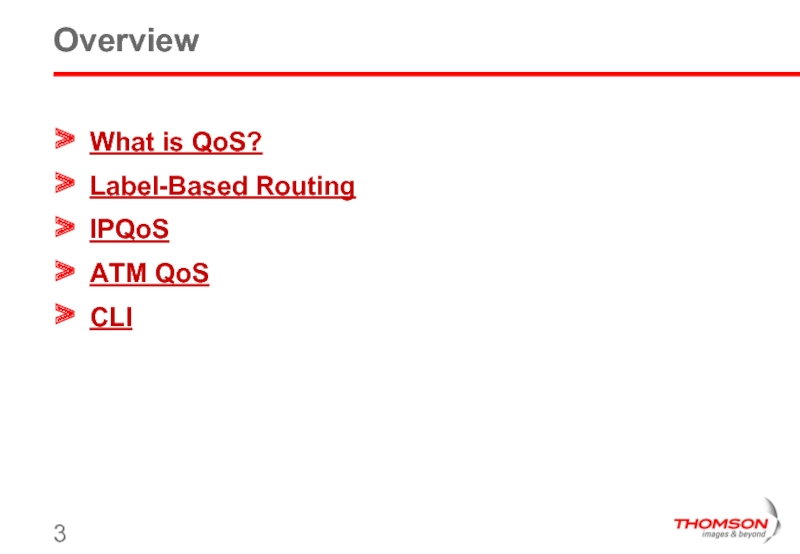
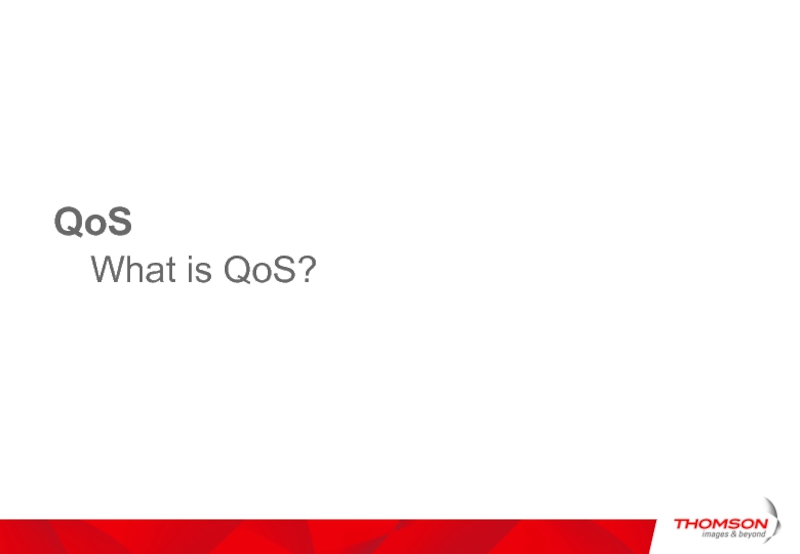
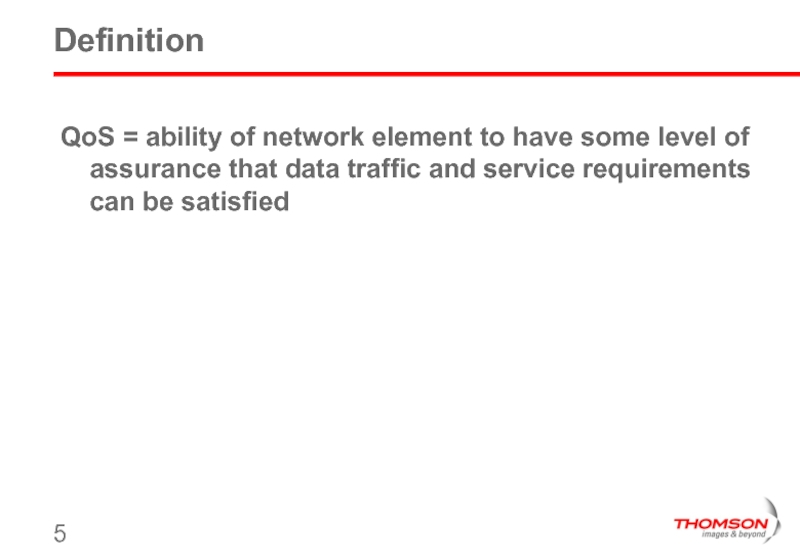

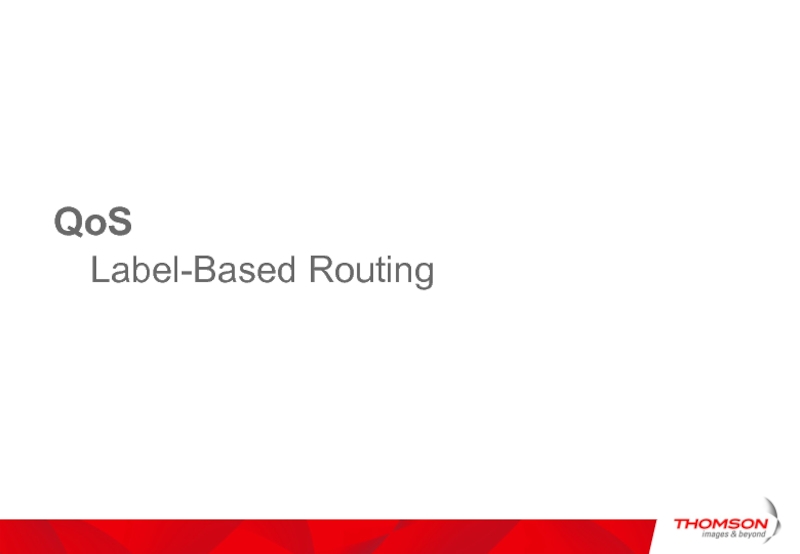
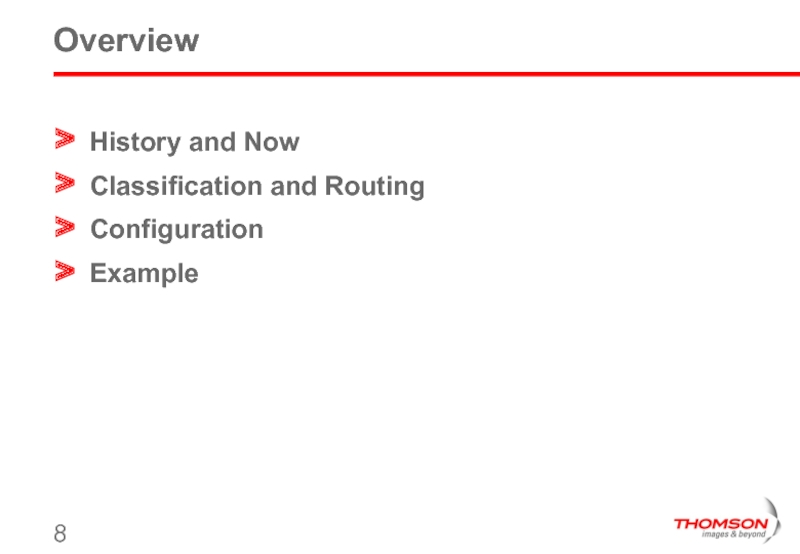
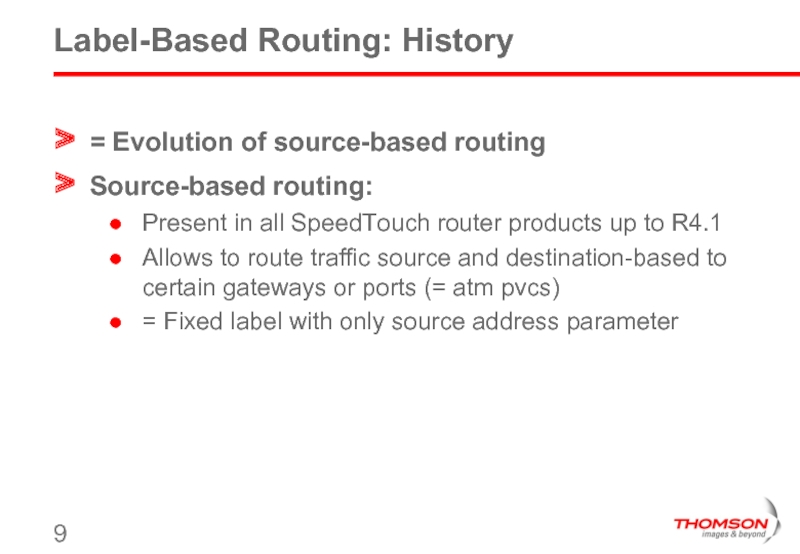
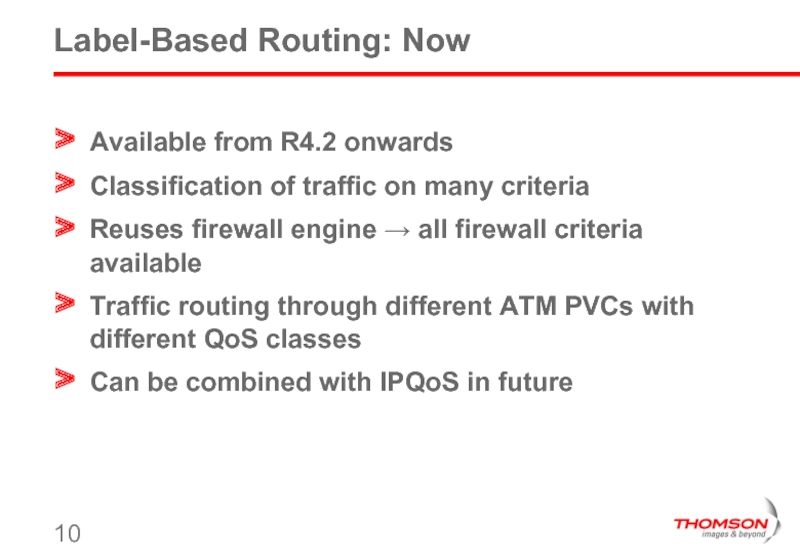
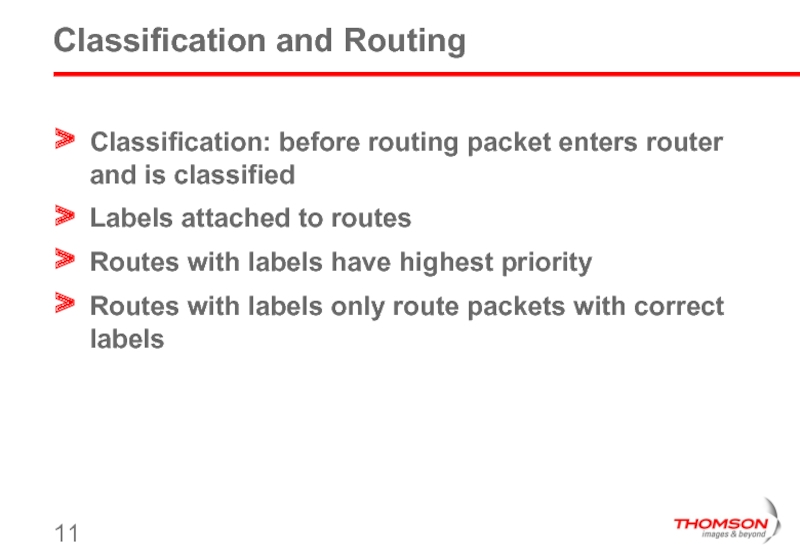
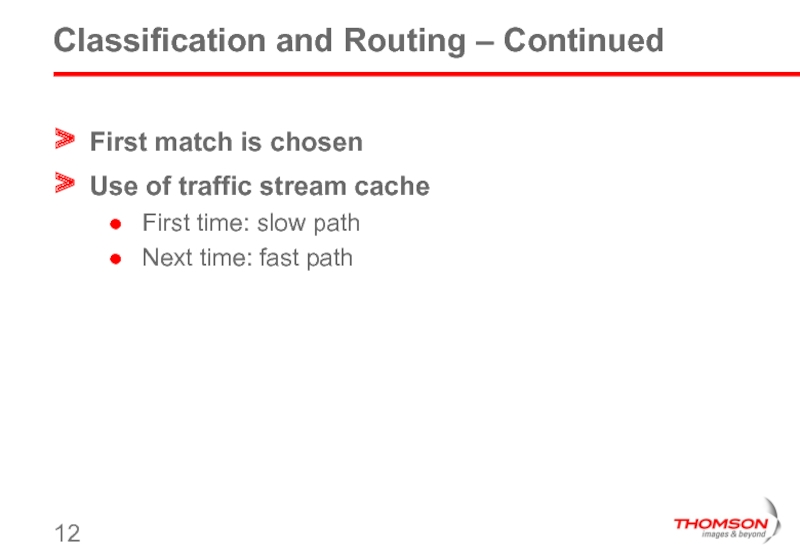
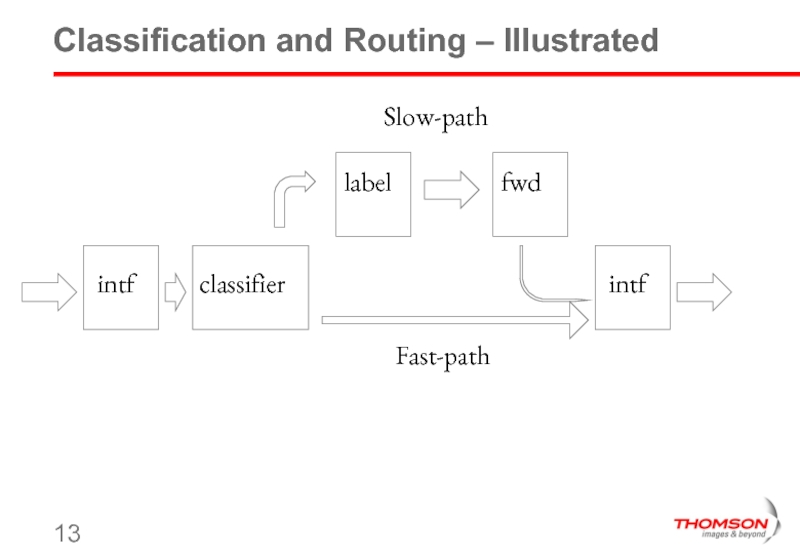
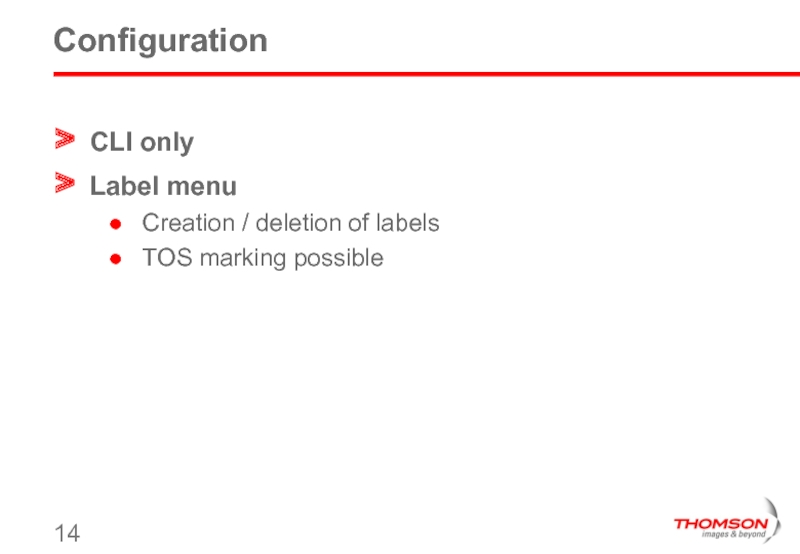


![RulesSource Interface (preferably NOT used)[srcintf [!]= ] Source Interface Group (preferably used)[srcintfgrp [!]= ] IPsrc](/img/tmb/1/9368/4151c54834e06203962d9be81b8dcbd4-800x.jpg)
![Rules – ContinuedToS (tagging)tos [!]= precedence [!]= dscp [!]= Protocolprot [!] = Portsrcport [!] &](/img/tmb/1/9368/7eb42e7af2b9cdae5f28a2537ef29515-800x.jpg)
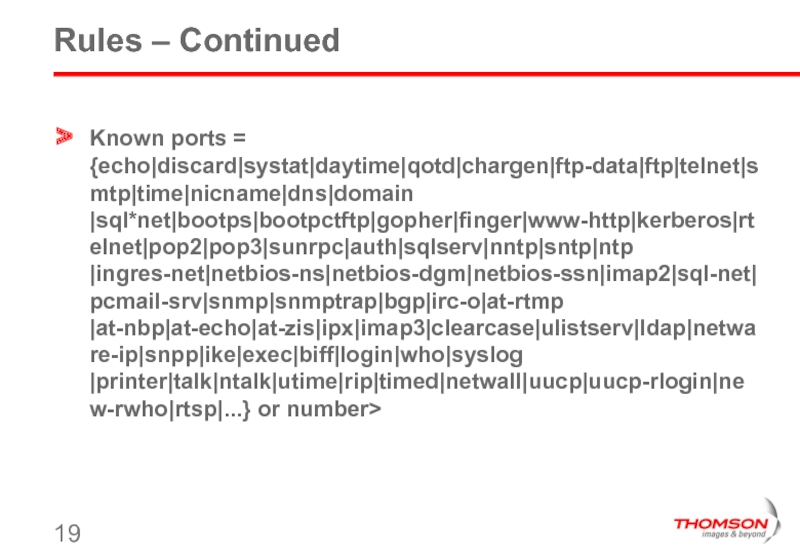
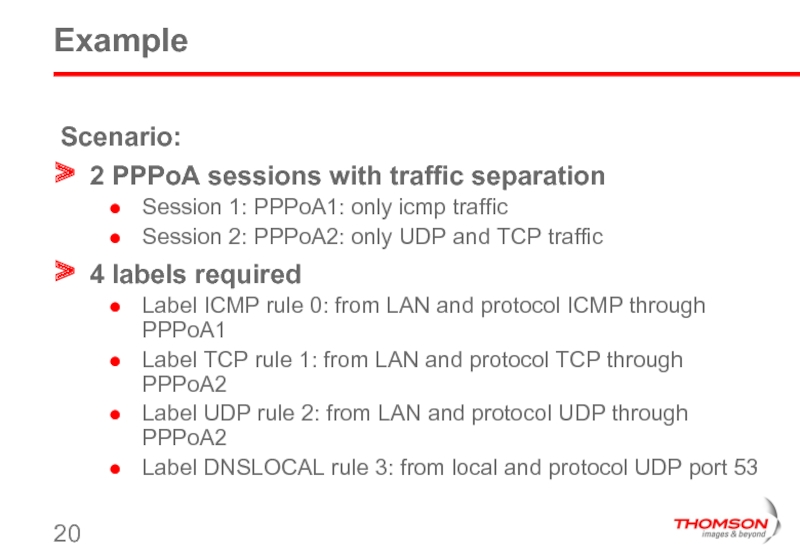
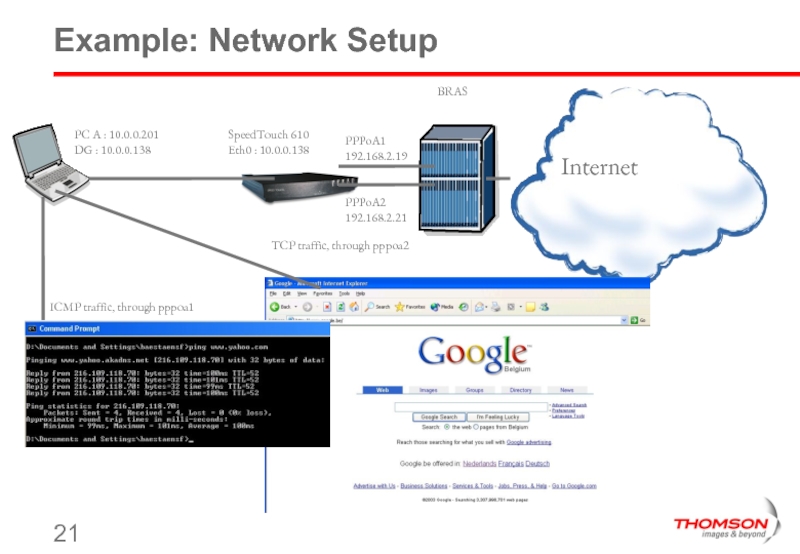

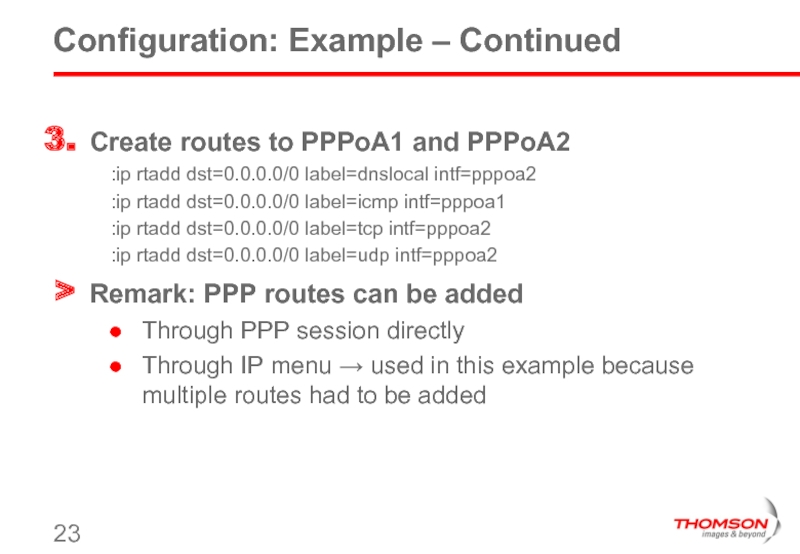
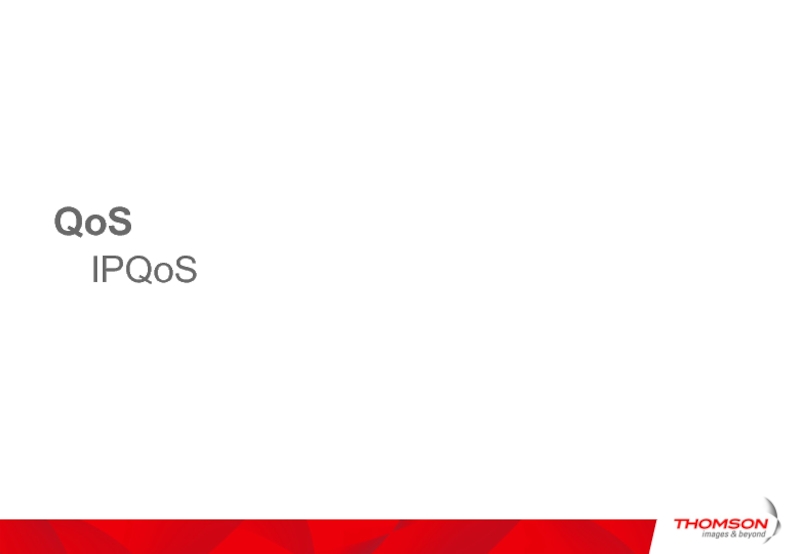
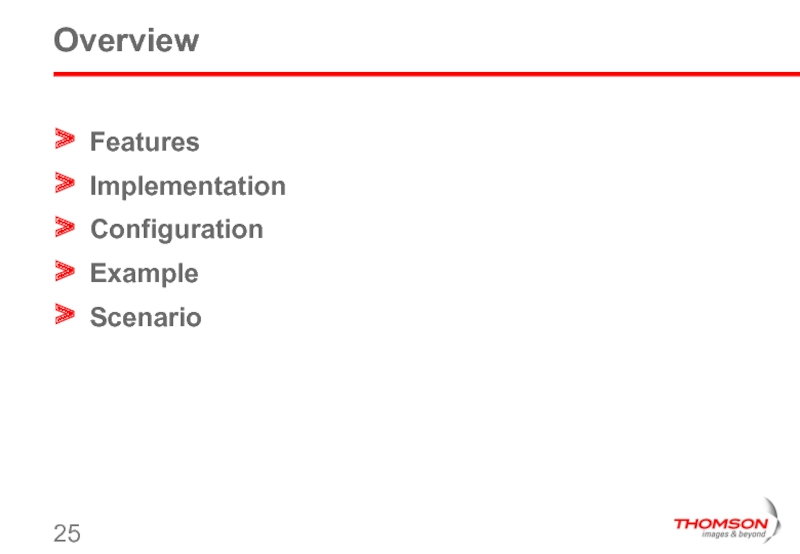
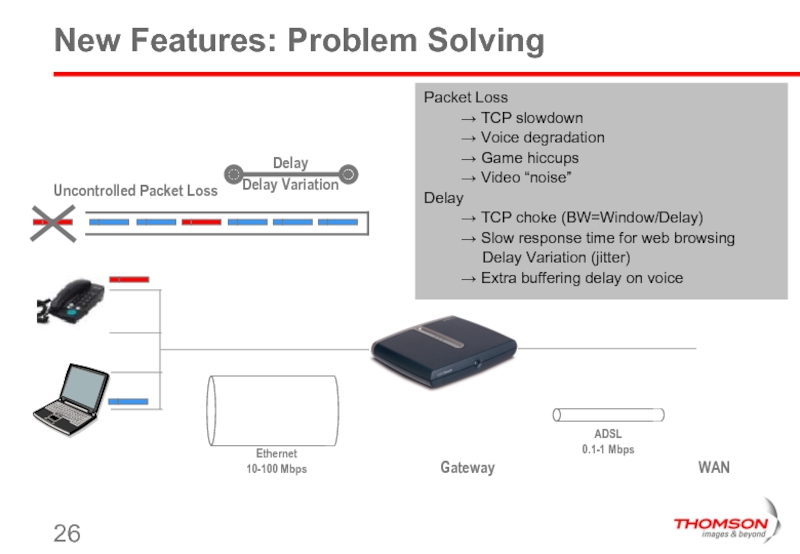
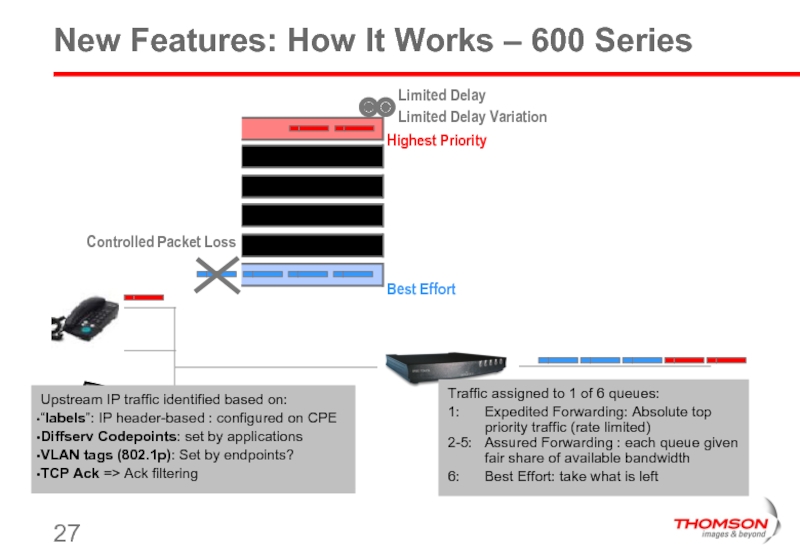
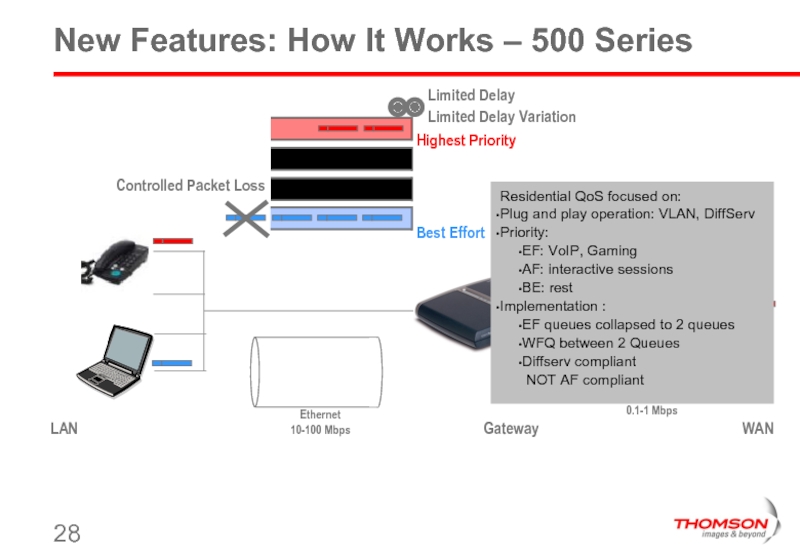

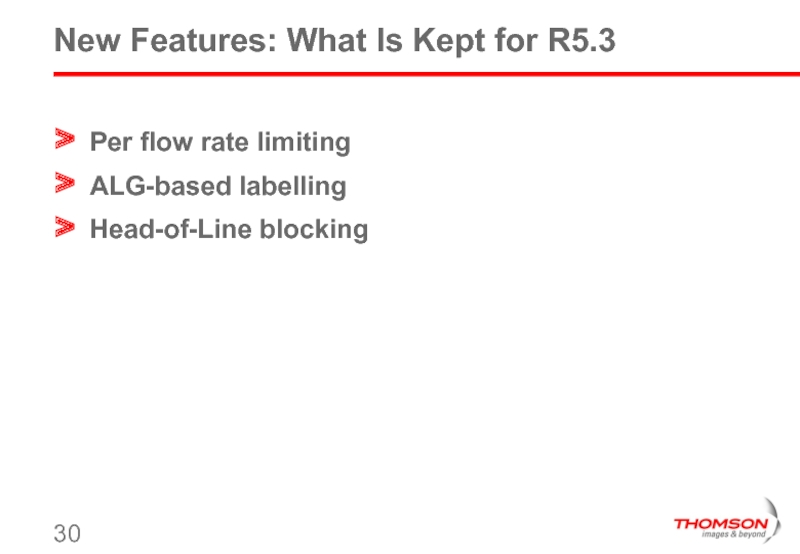
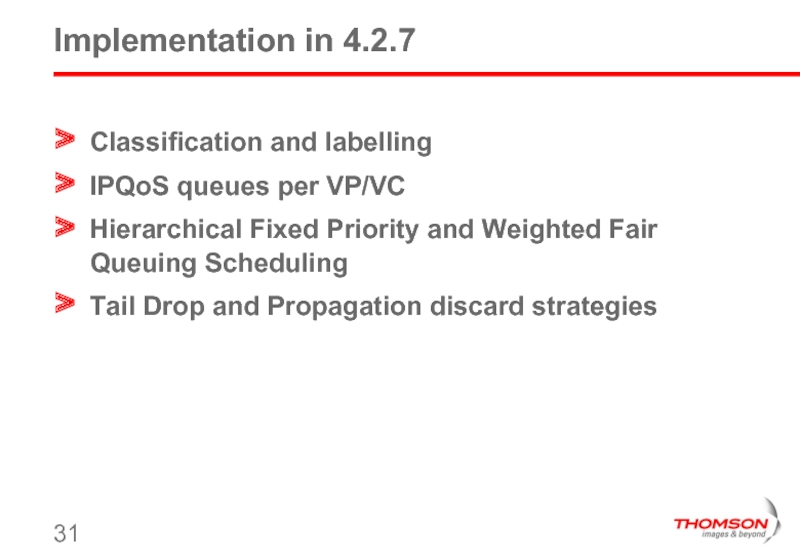
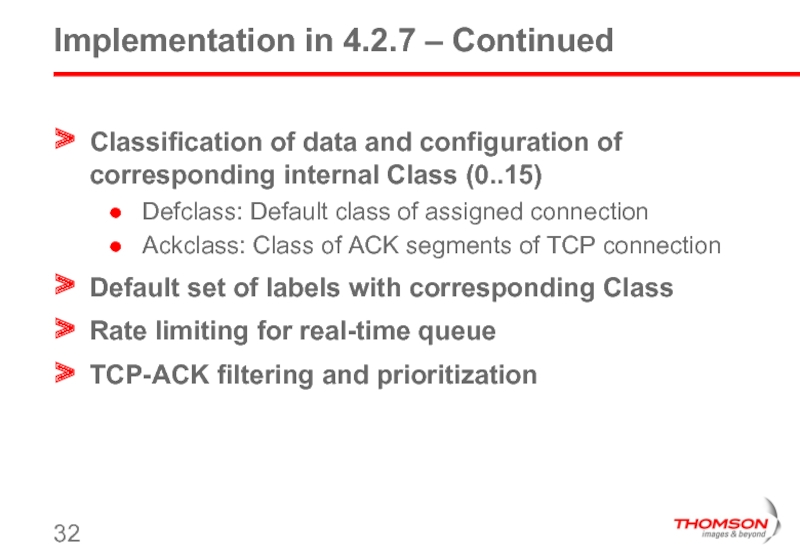

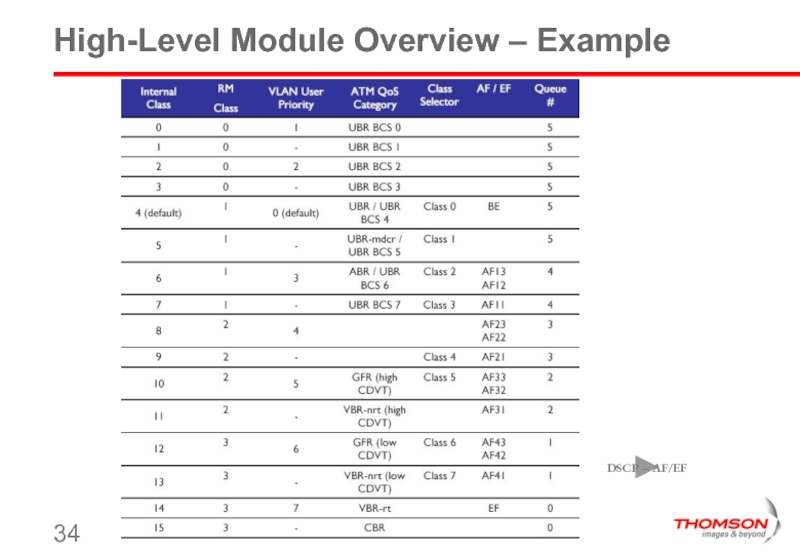
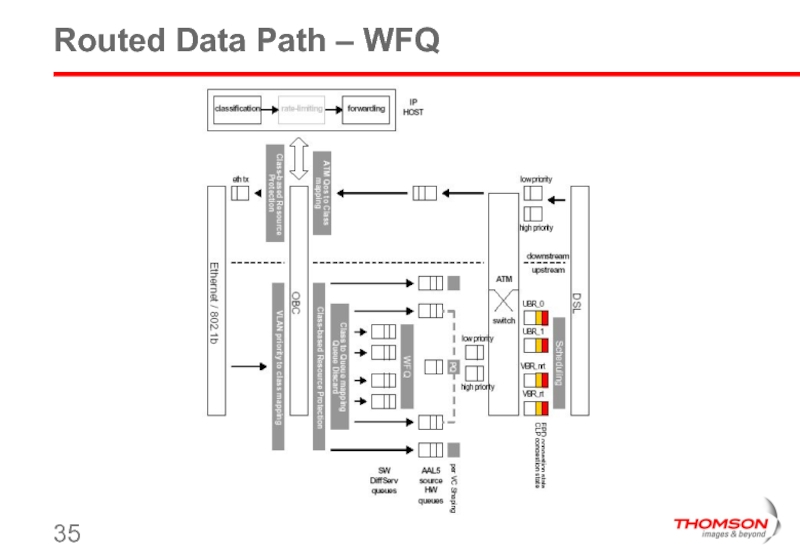
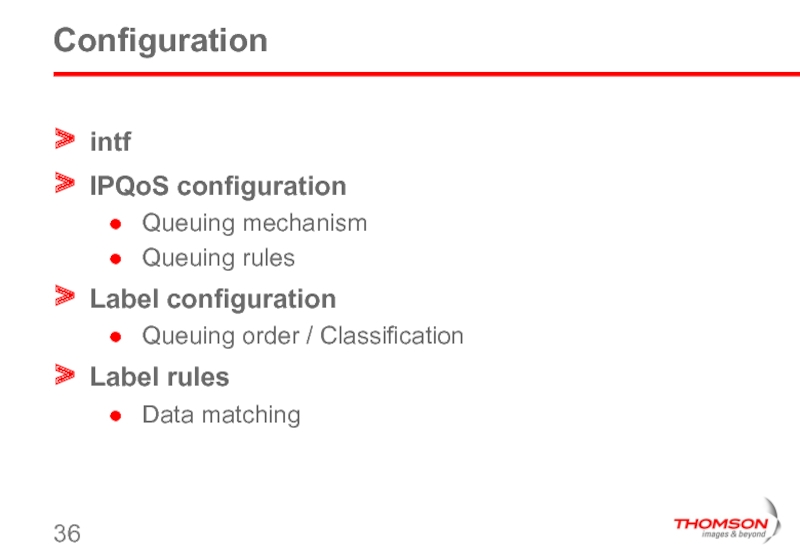
![IPQoS Configuration – CLIdest = destination of interface (phonebook entry)[state = ] Enable, disable](/img/tmb/1/9368/c7baed72ecabeb6f432d491b9568a542-800x.jpg)
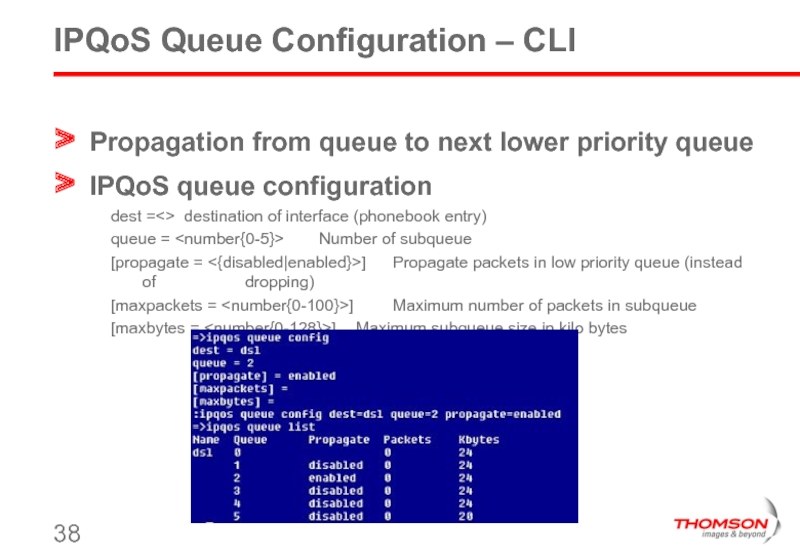
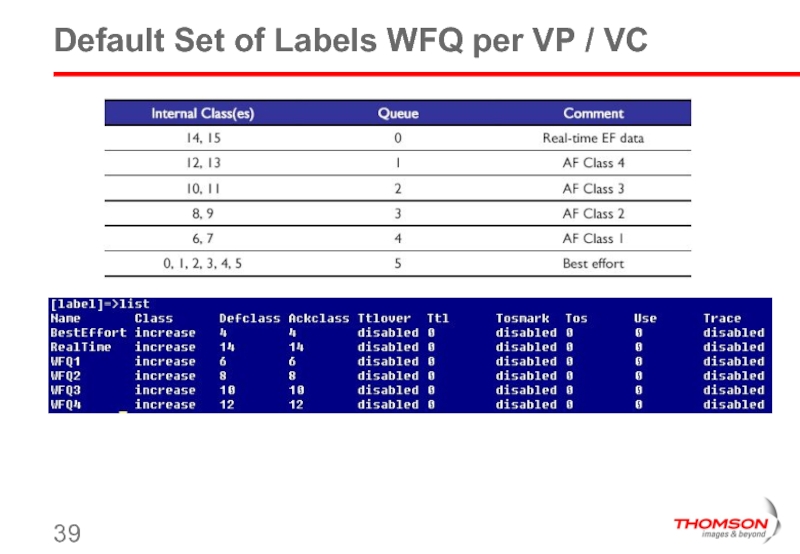
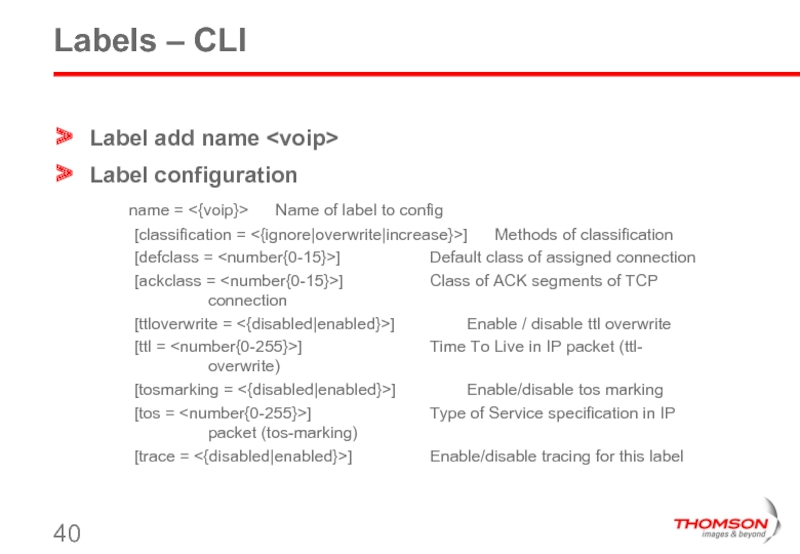
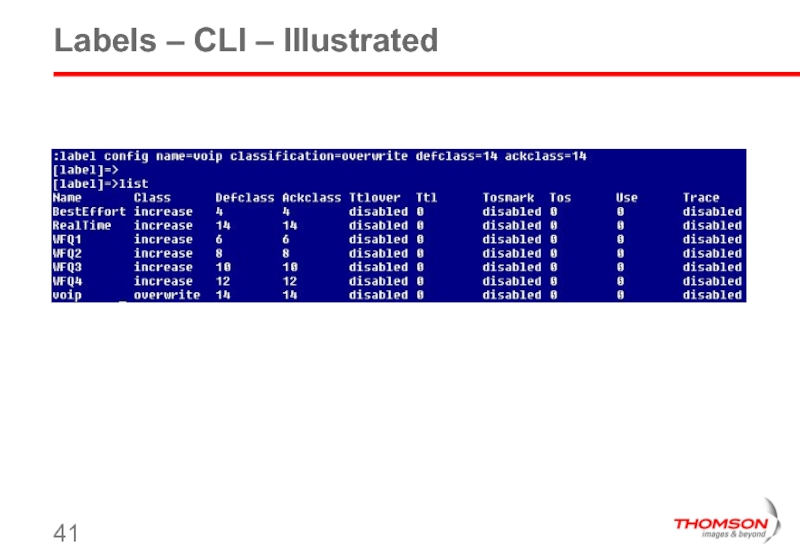
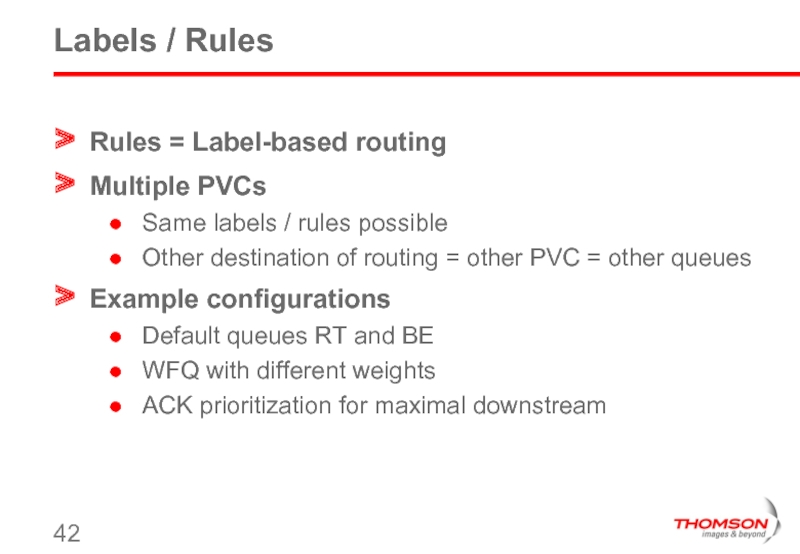
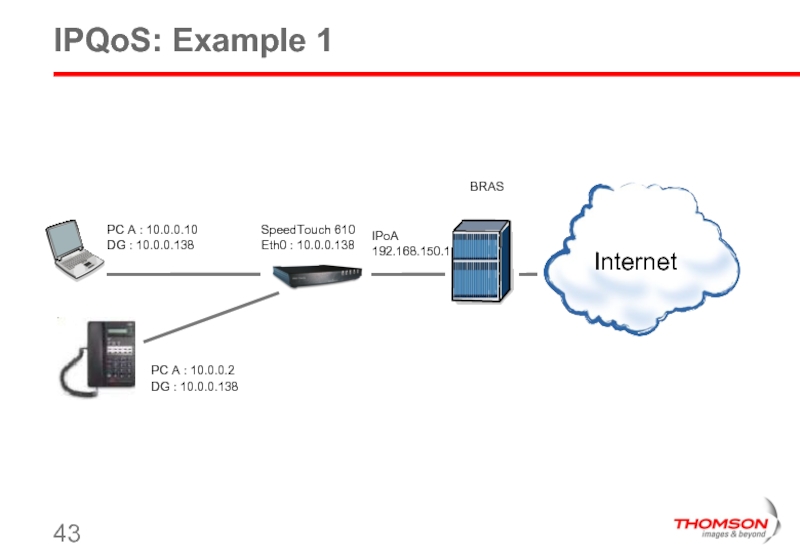
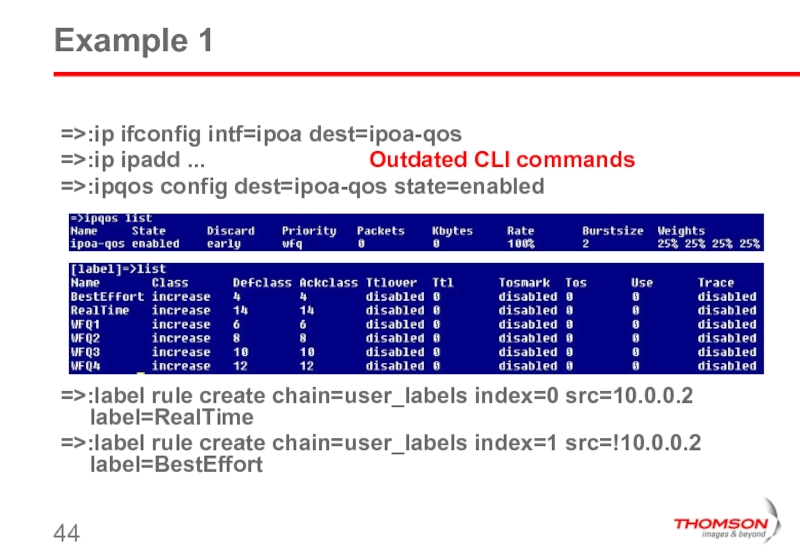
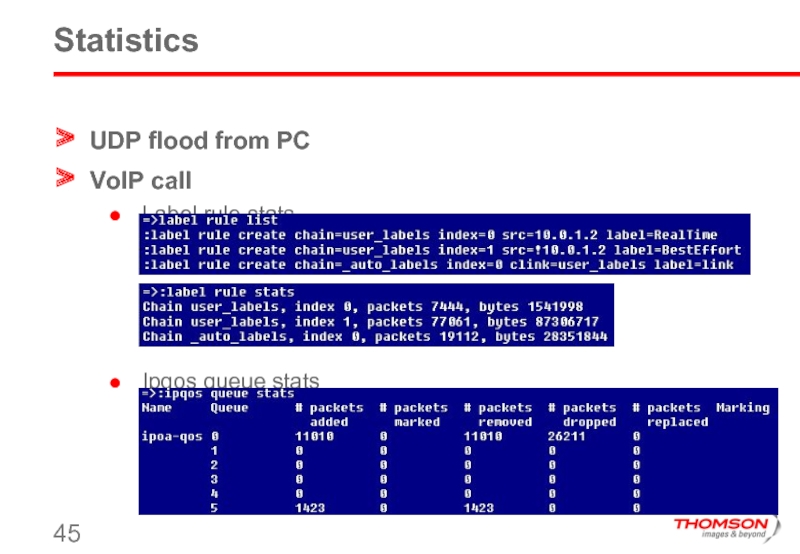
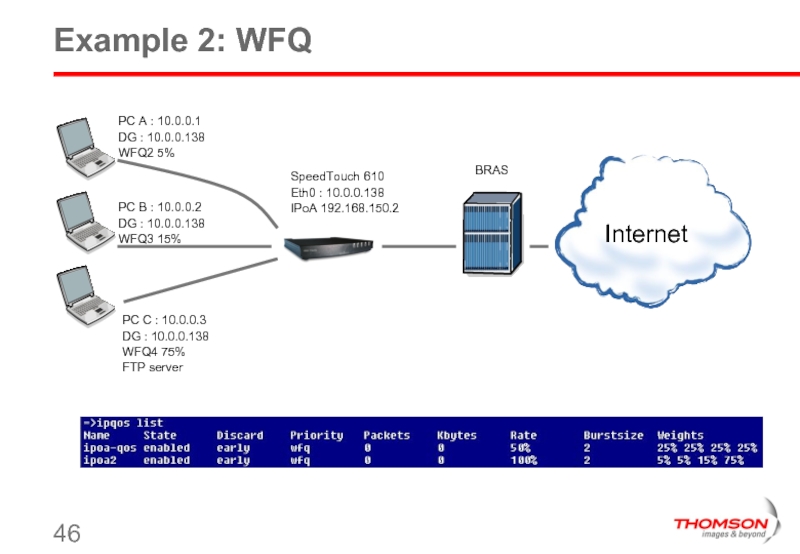
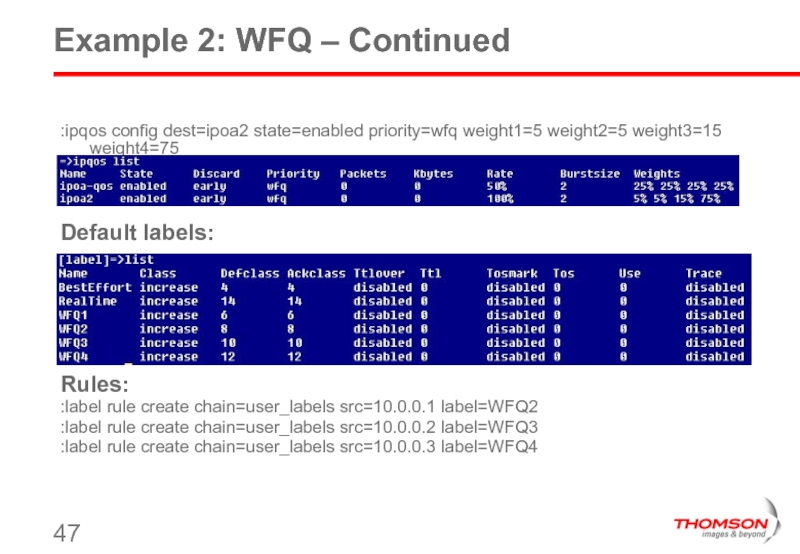
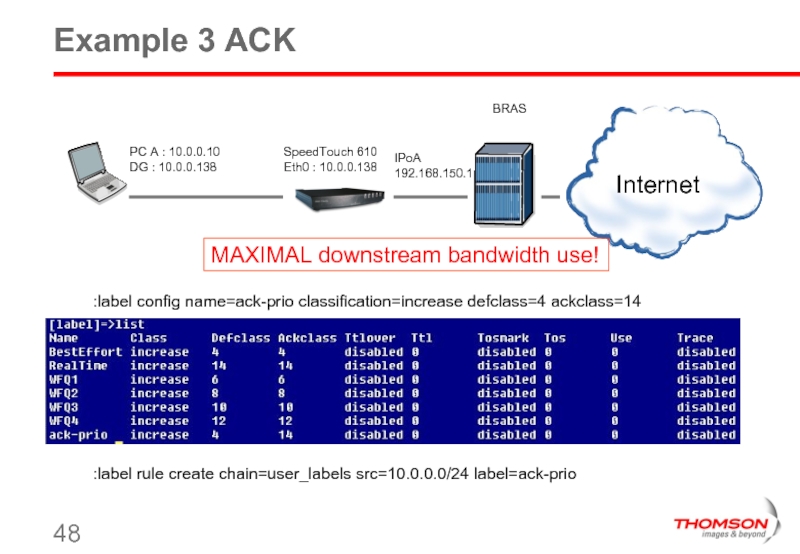
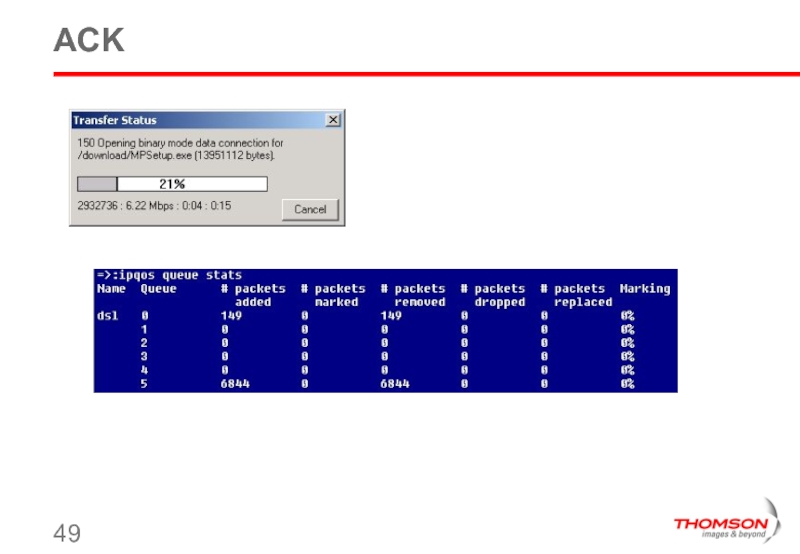
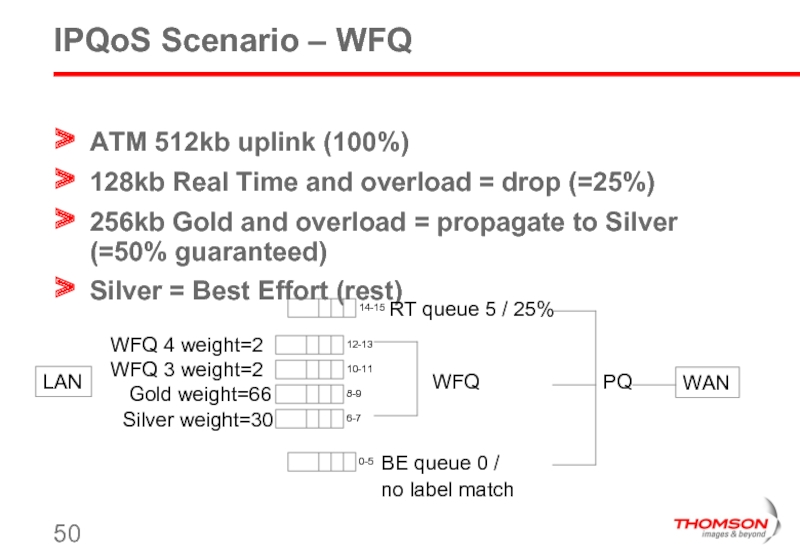
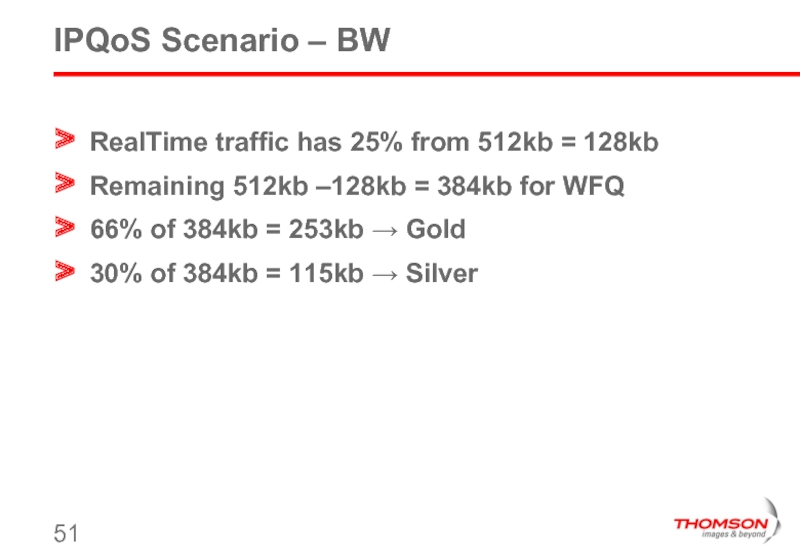


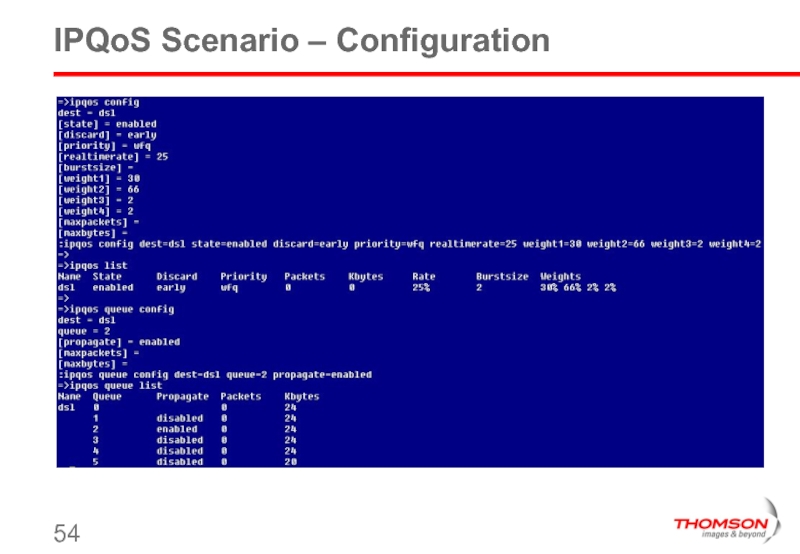
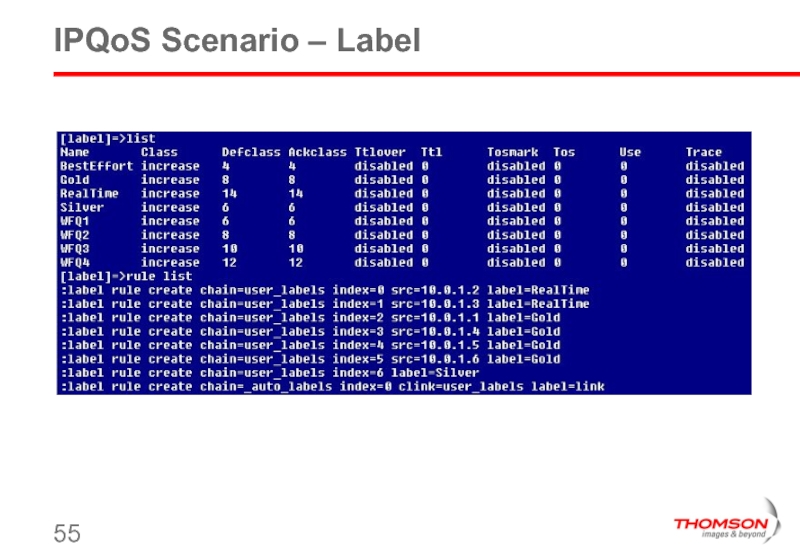
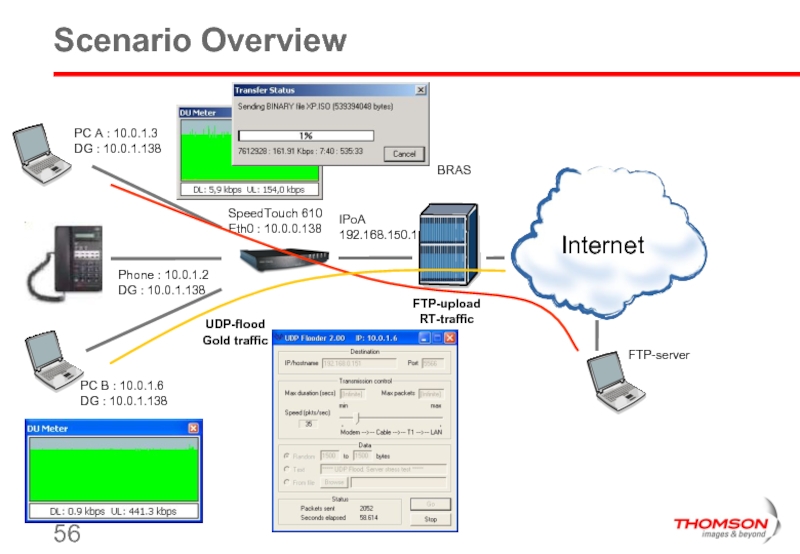
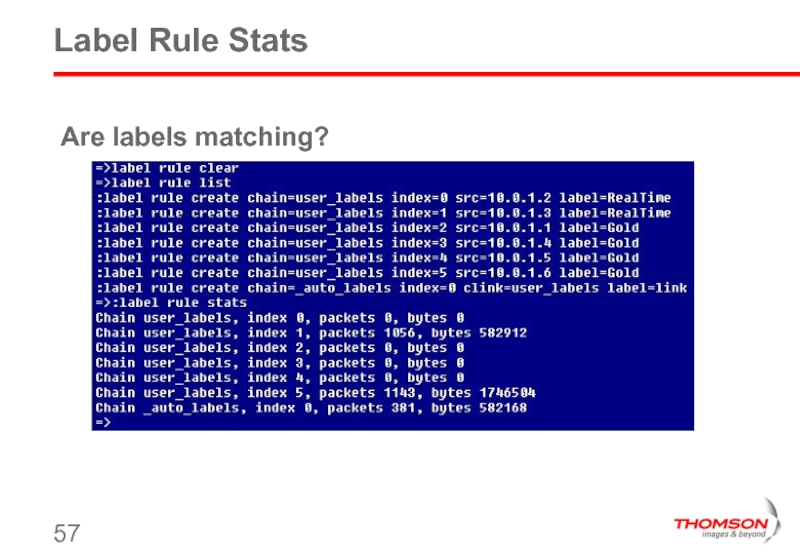
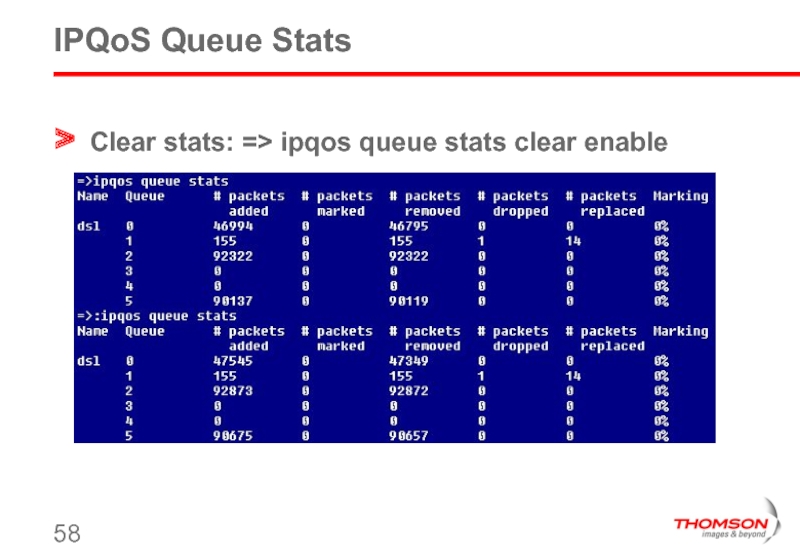
![user.ini[ phone.ini ]add name=dsl addr=0*38 type=ipoa[ ipoa.ini ]ifadd intf=ipoa dest=dslifconfig intf=ipoaifattach intf=ipoa[ ipqos.ini ]config dest=dsl](/img/tmb/1/9368/b51e198f6ef9852d05f7fcc6c8acfca9-800x.jpg)
![user.ini – Continued[ label.ini ]add name=BestEffortadd name=Goldadd name=RealTimeadd name=Silveradd name=WFQ1add name=WFQ2add name=WFQ3add name=WFQ4config name=BestEffort classification=increase](/img/tmb/1/9368/81a3a2baf3a54ca5de257be7d1e1dbc9-800x.jpg)



